PG. 23 + PG. 38 Breaking Bread at Clark Park
money
talks

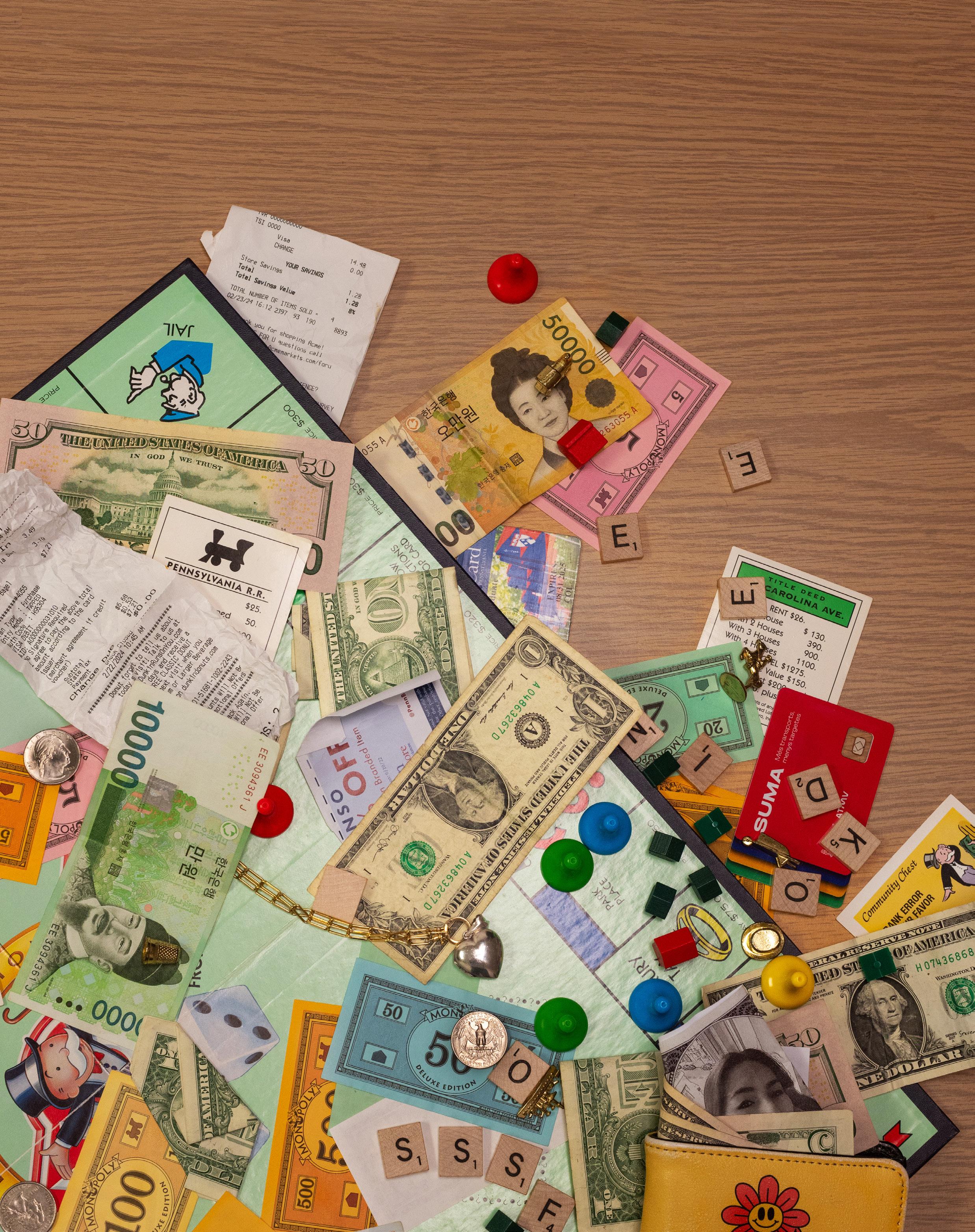
MARCH 2024
Donors Rule Everything Around Me PG. 8
Did They Just Kill Magill?


















































2 Get more from your shopping. Weekly digital deals and special offers* Easy online shopping Meal planning inspiration Health services * Subject to program terms. Visit acmemarkets.com/foru-guest.html for full terms and conditions. Download the ACME markets app STUDYING LATE? WE’RE OPEN LATE! Domino’sTM SUN-THURS: 10AM - 2AM FRI & SAT 10AM - 3AM WE MAKE ORDERING EASY! CALL DIRECT OR CHOOSE YOUR ONLINE OR MOBILE DEVICE RECEIVE a FREE! 8 Pcs of Bread Twist (3 options) Use Coupon Code [8149] | Minimum $15 Purchase Delivery Only WHEN YOU ORDER ONLINE 215-557-0940 401 N. 21st St. 215-662-1400 4438 Chestnut St.
38 18
Breaking Bread at Clark Park
It's 11:14 a.m. on a muggy Saturday and Clark Park Farmers' Market is humming with life.
Follow the Money Trail
A week in the life of a Penn student's credit card.
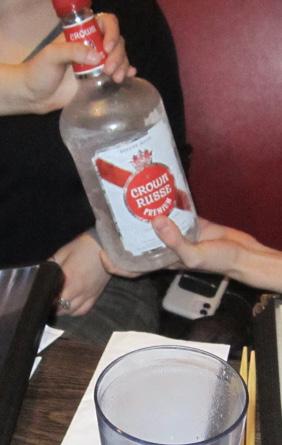
36 1 6
The Untold Story of the Philly BYO
Your Friday night Ambrosia is a modern day adaptation of a Philadelphia's history of prohibition.
The Galleries at the Philadelphia Museum of Art that No One Talks About Don't have 14 dollars for a ticket?
43
Amplifying Unhoused Voices Through the Power of Art
The Mütter Museum's new art exhibit explores the unhoused experience through the lens of public health.


8
14
Did They Just Kill Magill?
The newest season of Law and Order begins with an episode that parallels Penn's latest free speech troubles.
Like Taking Collagen From a Baby Sephora is the new sandbox.
FEATURE
Donors Rule Everything Around Me
When money talks, professors are silenced.

23

ON THE COVER
Our gambling addiction all began with monopoly. But if we lost, that money would go fying everywhere on the board.
By Jean Park
LETTER FROM THE EDITOR
Philosophizing On Material Girls, Money Troubles, and the Multi–Level–Marketing Scheme of a College Education.
At Penn, status is a currency in its own right. Money pumps through the veins of our university—our eyes always green with envy and grasses always seeming greener on the other side of recruitment cycles. Penn is the place where Golden Goose sneakers traipse down Locust and Goyard purses are stuffed to the brim with laptops, Essentia water bottles, and platinum cards. In the words of Madonna, we’re material girls living in a material world.
The gap between the haves and the have–nots at Penn is a cavern. While students jet off to tropical vacations for spring break, other students are knee–deep in belabored FAFSA documents. Sure, our clothes, spending habits, and social groups are indicative of wealth and privilege, but these proxies just scratch the surface of class division at our university.
Last month, The Cut published an article by their financial columnist titled “The Day I Put $50,000 in a Shoe Box and Handed It to a Stranger: I never thought I was the kind of person to fall for a scam.” The internet was set ablaze with debate. Sects of the internet quickly formed, some arguing that they could never fall for such a scam while others sympathized with her.
But let’s be real—we fall for scams every. Single. Day. While we might not be shit out of $50k, we’ve all been swept up in Penn’s financial schemes. From a heinous two—year living and dining plan that promises dorm power outages and cockroaches a-la-mode to the rising cost of tuition, we’re being fleeced. Nevertheless, we persist because we’re told that the Penn education will open doors for us, launch our careers, and yes, hopefully help us “secure the bag.”
However, the promise of financial security post–graduation can mean different things for a student population that ranges from first–generation students to your neighborhood nepo baby. We’re told repeatedly that a Penn education is a privilege in and of itself, but to capitalize off the Ivy name brand students succumb to the pre–professional tides. And who can
blame the student with four years of debt for pursuing their consulting dreams?
Our money troubles took on a new meaning this past fall, extending beyond our pre–professional predicaments. Brought to the forefront of a nationwide debate on academic freedom spearheaded by some of Penn’s wealthiest alumni and donors, Penn underwent a once–in–a–generation identity crisis. In the wake, we’re left to question the role of donors and money in our academic institution.
This month Street explores the age–old adage: “money talks.” From the streets of Philly to the halls of Goldman we lament the graveyard of our artistic dreams abandoned in pursuit of “realistic” prospects. When that first big–girl investment banking check hits we turn to finance influencers on TikTok to tell us how to reinvest to maximize our gains for the future home that we probably won’t be able to afford anyway. Now, as the spotlight fades from Penn’s campus after a six–month whirlwind, we examine the state of free speech asking academics (in the brave words of Oprah) “Were you silent? Or were you silenced?”
While Street doesn’t have a five–point plan to reduce the cost of your Magic Gardens tickets this April or to successfully reinstate your academic freedom, we know better than anyone else that more money means more problems when cash rules everything around us.

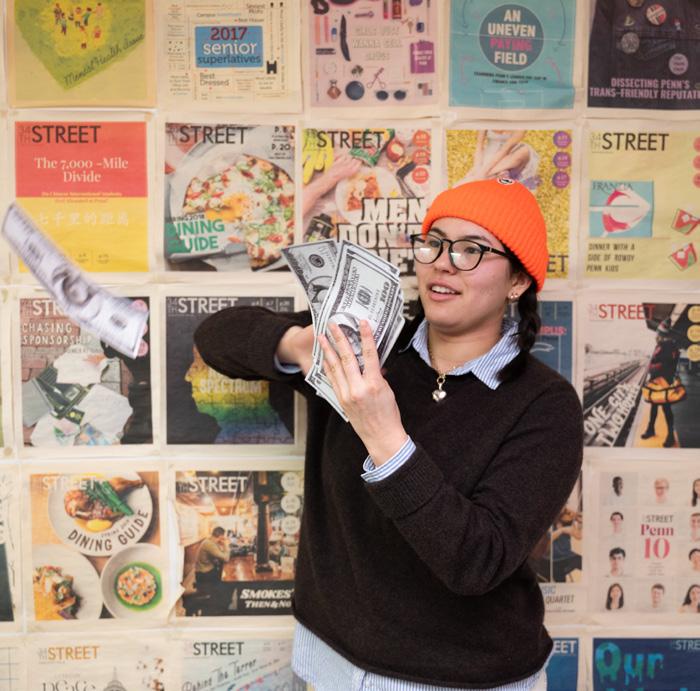
EXECUTIVE BOARD
EXECUTIVE BOARD
Natalia Castillo, Editor–in–Chief castillo@34st.com
Walden Green, Editor–in–Chief green@34st.com
Catherine Sorrentino, Print Managing Editor sorrentino@34st.com
Arielle Stanger, Print Managing Editor stanger@34st.com
Norah Rami, Digital Managing Editor rami@34st.com
Alana Bess, Digital Managing Editor bess@34st.com
Kate Ratner, Assignments Editor ratner@34st.com
Collin Wang, Design Editor wangc@34st.com
Wei-An Jin, Design Editor jin@thedp.com
EDITORS
EDITORS
Avalon Hinchman, Features Editor
Hannah Sung, Features Editor
Jean Paik, Features Editor
Jules Lingenfelter, Features Editor
Natalia Castillo, Assignments Editor
Anna O'Neill-Dietel, Focus Editor
Kate Ratner, Assignments Editor
Issac Pollack, Focus Editor
Anna O'Neill–Dietel, Focus Editor
Claire Kim, Style Editor
Naima Small, Style Editor
Sophia Rosser, Ego Editor
Norah Rami, Ego Editor
Nishamth Bhargava, Music Editor
Hannah Sung, Music Editor
Luiza Louback, Arts Editor
Irma Kiss, Arts Editor
Weike Li, Film & TV Editor
Weike Li, Film & TV Editor
Sophia Liu, Design Editor
Rachel Zhang, Multimedia Editor
Jean Park, Street Photo Editor
Kayla Cotter, Social Media Editor
Abhiram Juvvadi, Photo Editor
Jada Eible Hargro, Social Media Editor
THIS ISSUE
Julia Fischer, Copy Editor
THIS ISSUE
Deputy Design Editors
Charlotte Bott, Copy Editor
Wei–An Jin, Ani Nguyen Le, Sophia Liu
Laura Shin, Copy Editor
Design Associates
Deputy Design Editors
Insia Haque, Katrina Itona, Erin Ma, Janine Navalta
Anish Garimidi, Emmi Wu, Insia Haque, Janine Navalta, Katrina Itona Design Associates
STAFF
Asha Chawla
Features Staff Writers
Katie Bartlett, Delaney Parks, Sejal Sangani
STAFF
Focus Beat Writers
Features Staff Writers
Leo Biehl, Dedeepya Guthikonda, Sara Heim, Sophia Rosser, Rahul Variar
Style Beat Writers
Claeb Crain, Keira Feng, Eleanor Grauke, Meeiling Mathur, Lily Markis Mclean, Delaney Parks, Luiza Sulea
Focus Beat Writers
Layla Brooks, Emma Halper, Alexandra Kanan, Claire Kim, Felicitas Tananibe
Music Beat Writers
Maddy Brunson, Charissa Hooward, Prerna Kulkarni, Bobby McCaann, Ellie Meyer, Chloe Norman
Kelly Cho, Halla Elkhwad, Ryanne Mills, Olivia Reynolds, Mehreen Syed
Style Beat Writers
Arts Beat Writers
Madeline Kohn, Steven Li, Natasha Yao
Jojo Buccini, Jessa Glassman, Eyana Lao
Music Beat Writers
Film & TV Beat Writers
Jake Falconer, Meehreen Syed, Ananya Varshneya
Mollie Benn, Kayla Cotter, Emma Marks, Isaac Pollock, Catherine Sorrentino
Arts Beat Writers
Ego Beat Writers
Sophie Barkan, Noah Goldfischer, Ella Sohn, Vikki Xu
Maya Grunschlag, Dylan Grossmann, Kyunghwan Lim, Neha Peddinti, Hannah Qiu
Film & TV Beat Writers
Staff Writers
Aden Berger, Bea Hammam, Emma Halpher, Fiona Herzog, Erin Jeon, Amy Luo, Thu Pham
Ego Beat Writers
Morgan Crawford, Heaven Cross, Angele Diamacoune, Rayan Jawa, Enne Kim, Jules Lingenfelter, Luiza Louback, Dianna Trujillo Magdalena, Yeeun Yoo
Audience Engagement Associates
Sophie Barkan, Parin Keerthi, Gemma Levy, Talia Shapiro, Ella Shusterman, Leah Weinberger, Rosemary Yang
Staff Writers
Annie Bingle, Ivanna Dudych, Yamila Frej, Lauren Pantzer, Felicitas Tananibe, Liv Yun
Charlotte Comstock, Julia Fischer, Caitlyn Iaccino, Andrew Lu, Maia Saks, Zaara Shafi, Aaron Visser
LAND ACKNOWLEDGEMENT
LAND ACKNOWLEDGEMENT
The Land on which the office of The Daily Pennsylvanian stands is a part of the homeland and territory of the Lenni-Lenape people. We affirm Indigenous sovereignty and will work to hold the DP and the University of Pennsylvania more accountable to the needs of Indigenous people.
The Land on which the office of The Daily Pennsylvanian stands is a part of the homeland and territory of the Lenni-Lenape people. We affirm Indigenous sovereignty and will work to hold the DP and the University of Pennsylvania more accountable to the needs of Indigenous people.
CONTACTING 34 th STREET MAGAZINE
CONTACTING 34 th STREET MAGAZINE
If you have questions, comments, complaints or letters to the editor, email Walden Green, Editor–in–Chief, at green@34st.com You can also call us at (215) 422–4640.
If you have questions, comments, complaints or letters to the editor, email Natalia Castillo, Editor–in–Chief, at castillo@34st.com You can also call us at (215) 422–4640.
www.34st.com © 2023 34th Street Magazine, The Daily Pennsylvanian, Inc. No part may be reproduced in whole or in part without the express, written consent of the editors. All rights reserved.
www.34st.com © 2023 34th Street Magazine, The Daily Pennsylvanian, Inc. No part may be reproduced in whole or in part without the express, written consent of the editors. All rights reserved.
34 TH STREET MAGAZINE 4
STROOSE
YHBPYANOOMEE
Photo by Jean Park
Hometown
Union City, New Jersey
Major Nursing Activities
Minorities in Nursing Organization, Penn Tabletop, Penn First Plus, Research with Kathryn H. Bowles, Adriana Perez, George Demiris, Nancy A. Hodgson, and Maya N. Clark–Cutaia, TA for Jianghong Liu
Growing up with her grandparents, Samantha Cueto (N ‘24) developed a soft spot for the geriatric population. Now a senior at the School of Nursing, Samantha has dedicated her time at college toward conducting extensive research supporting the elderly. She has particularly enjoyed spearheading a community–based intervention aimed at increasing physical activity among Hispanic elderly individuals with dementia or cognitive impairment. When Samantha's not helping elderly patients at local hospitals and clinics or uncovering medical breakthroughs in the research labs, she’s playing Dungeons and Dragons with Penn Tabletop Club, practicing Japanese, or watching horror movies with her friends. Samatha’s positive energy radiates when she expresses her gratitude to her friends, the people who have undoubtedly made her Penn experience.
What inspired you to apply to Nursing?
When I was a senior in high school, we had to do a bunch of volunteer hours. Initially, I didn't think that I would go into nursing because my mom is a nurse and I was always like, “I don’t want to do what my mom does.” But, I ended up volunteering at an elderly care center. For background, I feel like my grandparents had a really big part in raising me, so I've always had a soft spot for the geriatric

Samantha Cueto
With countless hours spent in the research lab, Samantha Cueto is making a profound on the Philly community.
BY SOPHIE BARKAN
T his in T erview has been edi T ed and condensed for clari T y
Photos courtesy of Samantha Cueto
CAMPUS EGO OF THE MONTH EOTM
population. My time volunteering at the elderly care center included assisting the people in daily living, having conversations with them, and working with nurses. I also talked to the nurses about why they began their careers. In high school I really loved science, but I'm also a pretty sociable person. So, I wanted a career where I'd be talking to people and not one where I’d be behind a desk all day. I also didn't want to go to medical school for seven years. That’s a long time! When I visited Penn, I spoke to the admissions director of [the School of] Nursing. She explained that there are so many career paths for nursing such as midwifery and pediatrics. Talking to her really helped me zone in on that, and I decided to look into nursing.
How has your interest in the geriatric population influenced your research at Penn?
I've done tons of research at Penn. I'm super detail–oriented, and I like working on these projects and seeing them slowly build up. Since freshman year, I've always held around two to three jobs and have tried to do as many research opportunities as I could. I've always loved working with these professors and doing various projects.
A lot of my research focuses on elderly people. For example, I worked for Dr. George Demiris for one summer, and I was able to talk to researchers in Japan about the technology they are building for elderly people. Right now, I'm working with Dr. Kathryn H. Bowles, and I go into the hospital and talk to patients with sepsis. I interview them for about an hour and talk to them about their experiences having sepsis. I like doing research because you really get to see the gaps in the current healthcare system and make a direct impact on people.
I also worked with Dr. Adriana Perez, and her research left a big impact on me. It was my target population, the elderly population, but specifically, we worked with Hispanic elderly individuals with
dementia or cognitive impairment. That really meant a lot to me coming from a Hispanic background. It was the first time that I started going out into the field, meeting the people face–to–face, and talking to them. This research was a community–based intervention where we were trying to increase exercise in these Hispanic communities. They were living in apartments together, and I would go in and conduct interviews. The Hispanic elderly individuals were always so friendly. When we would come into their homes they would offer us food. I felt like I was talking to my grandparents every time I was talking to them because they were so friendly and treated me like family immediately. By going out into the field and being in their space, I was able to learn about their lifestyles. It was my first time actually working with these research tools
and translating this type of friendly conversation into empirical evidence.
What has been your favorite clinical experience during your time at Penn?
My clinical last semester was for community health at Nurse–Family Partnership. Their patient population were mothers with infants up to three–years–old or pregnant mothers. We would go into their homes and do a lot of patient education. For example, if a mother was six months pregnant, we would tell them not to do a lot of exercise. Or, if we were dealing with a mother with a two year old, we would talk about introducing new foods. I really liked it because I feel like with community nursing, you get to make the widest impact on people, and you get to directly meet them too. These were low–income mothers as well, and

34 TH STREET MAGAZINE 6
CAMPUS EGO OF THE MONTH
many of them were on food stamps or had trouble maintaining their jobs. I was really happy talking to them and learning more about them. It just reminded me of why I went into nursing in the first place. I really liked that clinical most as it allowed me to reach so many people in need.
How has being FGLI impacted your Penn experience?
That was actually how I met my very first friends at Penn. I would say I'm low–income, but I'm not first gen. Still, I was invited to the Penn First Plus pre–freshman program, and that's how I was able to meet my nursing friends. Those are the very first friends that I made. It's been so fun and amazing with them. It's good to talk to them and stick together because I feel like sometimes at Penn, impostor syndrome is really, really big, especially coming from a low–income background.
Can you tell me about your involvement in Penn Tabletop club?
It's pretty nerdy. We play Dungeons and Dragons together. Freshman year, when it was COVID, this was where I first found my first group of friends. We would meet every weekend, talk to each other, and play together for a couple of hours. I’ve continued going throughout the years, and it’s been really fun. Penn Tabletop has definitely helped me feel creative. I was always unsure if I was creative until I played D&D and saw everyone’s ideas fly off each other and create really crazy scenarios.
What are some of your favorite things to do in your free time?
Japanese class was one of the best experiences I've had at Penn. I picked Japanese for a complete ego reason because I'm Latina and if someone asks me what languages I speak, I can say “English, Spanish, and Japanese.” Learning Japanese has a really close place in my heart. I love learning the language just because
it's completely different from English and it's just so rewarding.
I also really love playing with my Nintendo Switch. When my friends come over, sometimes, we will all play a game together. I've always loved Nintendo since I was a kid. Some of my earliest memories are from playing the consoles.
I also really enjoy watching movies. I've tried to take some cinema classes even though they're not in my nursing curriculum because I love talking about movies. Last year, I took Japanese cinema, and I loved watching the movies and talking about them in class. This year, I'm taking Korean cinema. My family loves horror, so I grew up watching horror. I think that some of the best horror movies are Korean horror movies. I literally joined the class just to talk about Korean horror movies and be exposed to more movies.
Where on campus have you found the best sense of community?
I have this one friend group that I joined sophomore year, and we’re a very
tight friend group. We meet nearly every day. Sophomore year when I first met them, we would go to the rooftop lounges in Harrison or Harnwell multiple times a week and stay there until 5 a.m. I loved the rooftop lounges, it was so much fun. Overall, I’ve just loved gathering with my friends in different places on campus. My friends are the people that have made my Penn experience.
What’s next for you after Penn?
Currently, I'm in a loan forgiveness program with Penn. They give me more aid junior and senior years but in return, I have to work for two years at the Penn Medicine Princeton Medical Center. I’m going to try and work in the ICU for two years at the Princeton Medical Center. After that, I'm currently unsure because I really, really love research, but I’ve also really liked my time that I've had in the ICU. I'm just going to see how I feel at the end of my two years. I'm either going to try and see if I can go to grad school for nursing anesthesia or go to grad school to do nursing research and get a Ph.D. ❋
Favorite place to eat around campus?
Ochatto (I know, it’s a hot take)
Favorite movie?
The Shining
No-skip song?
“See You Again” by Tyler, The Creator
Early bird or night owl?
Early bird by force
There are two types of people at Penn … The people who are career–driven and the ones that are more relaxed and enjoying college.
And you are?
I would like to say the enjoying college one, but I’m probably the career–driven one.
7 MARCH 2024
Did They Just Kill Magill?
The newest season of Law and Order begins with an episode that parallels Penn’s latest free speech troubles.
BY NORAH RAMI Graphic by Anish Garimidi
It’s late at night, the sky deep purple against the New York City skyline as Hudson University President Nathan Alpert walks home. He’s agitated; criticism has been coming from every direction. The campus is in the midst of mounting tensions between pro–Israel and pro–Palestine advocates. Donors have pulled out funding and student groups are protesting. He’s heading home though, complaining to his wife on the phone over the contents of the day and promised a relaxing night for his troubles. But he pauses mid sentence, noticing students spray painting political imagery onto a building. He yells out to them as they disperse and turns to leave. But in that movement, his eyes widen. Out of nowhere, a knife plunges into the president’s body. He falls.
The Law and Order theme song plays and the screen turns black, reading: "The following story is fictional and does not depict any actual person or event."
Did they just kill Liz Magill?
On Jan. 18, America’s favorite legal drama, Law and Order, aired the first episode of its 23rd season. Titled “Freedom of Expression,” the hour–long segment follows the unraveling of a trial surrounding the murder of imagined Hudson University President Nathan Alpert.
The episode is underscored by mounting tensions regarding free speech amid pro–Israel and pro–Palestine demonstrations. The university president remained a controversial figure, characterized by some as an irresponsible advocate of free speech and criticized by others as biased and politically immoral.
Despite opening with a disclaimer that all people and events depicted are "fictitious," Law and Order often explicitly draws inspiration from real–life crimes, from the contemporary Spa Shootings in Atlanta to the reemerging obsession with Jeffrey Dahmer. The show’s plots are often considered “ripped from the headlines.”
It’s clear that the Season 23 premiere is a close allegory of the current campus free speech conflict across the nation, referencing Penn most specifically. For the past year, former Penn President Liz Magill has faced scrutiny from all sides—donors, national media, and Congress—over her response to campus speech in the wake of the Israel–Hamas war, culminating in her resignation.
In the Law and Order episode, the Hudson University president is facing similar backlash for his handling of campus expression. The episode is littered with references that map almost exactly to real–life events that have
34 TH STREET MAGAZINE 8 CULTURE // FILM & TV
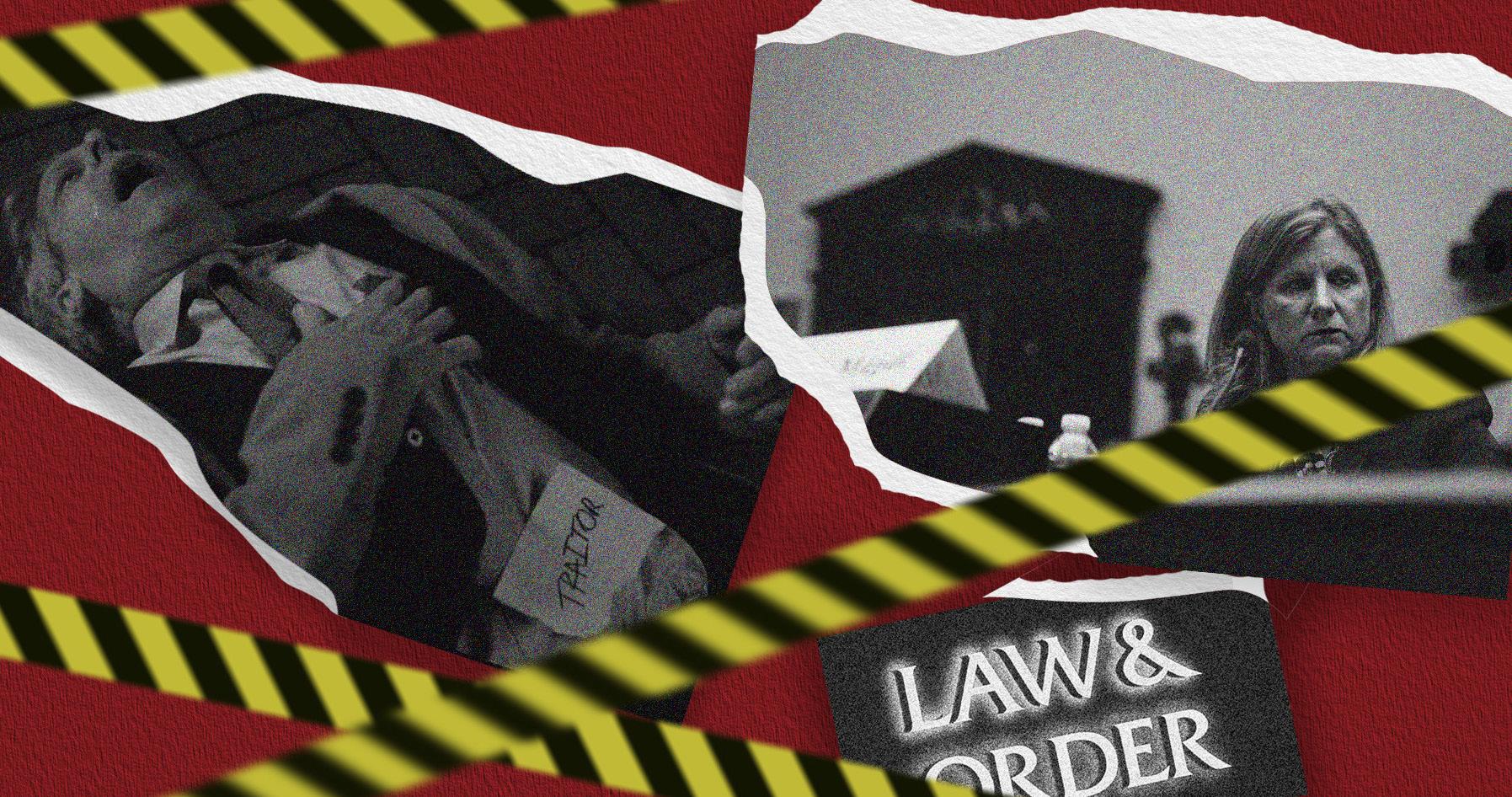
occurred here on campus, to the point that Alpert’s death seems representative of Magill's resignation.
In the episode, donors were pulling out funding from the fictional campus over a Palestinian film festival, which parallels the Palestine Writes Literature Festival that catalyzed Penn’s first wave of donor threats and pushback. Hudson University students who were organizing for Palestine were disappointed by their president’s threats to discipline a student group for showing a film critical of Israel, not far from Penn’s reaction to the Israelism screening by the progressive Jewish group Penn Chavurah. There’s even an out–of–place reference to a professor who was fired for criticizing transgender athletes, referencing a national cultural debate that took place center stage here at Penn.
At one point, a cop asks exactly what we’re all thinking, “Isn’t that like what happened at the University of Pennsylvania?”
It wasn’t until over two decades after he graduated from Penn that alumnus Dick Wolf (C '69) created the hit NBC show Law and Order With over 490 episodes, the show has developed into a full universe that has played a critical role in informing the American pub-
lic’s perception of the criminal justice system. Wolf, attributed as one of the richest men in television, has been closely involved with Penn’s campus, funding the development of the eponymous Wolf Humanities Center and endowing the Dick Wolf Associate Professor of Television and New Media Studies in the Cinema Studies Department.
In the last year, however, Wolf joined the ranks of donors who have cut ties with Penn. Wolf called for Magill and former Penn Board of Trustees Chair Scott Bok to resign over the Palestine Writes Literature Festival. On Oct. 18, 2023, Dick Wolf sent a letter to Penn on Law and Order letterhead criticizing what he viewed as the emergence of hate speech on Penn’s campus. Exactly three months later, those very criticisms were rendered tangible on an episode of Law and Order itself.
Like any serial drama, Law and Order doesn’t pretend to espouse deconstructive legal theory. Rather, the crimes are salacious, existing largely for the entertainment of the weekday cable television viewers. The show is formulaic and predictable. Wolf himself laid out the recipe for every Law and Order episode to The Washington Post, stating, “Stories reflect current events but the show is basically the
9
MARCH 2024
same. A murder mystery in the first half with a moral mystery in the back half.” Still, even with its lack of nuance, it provides unique insight to how the public understands and interprets the nature of the current events and crimes depicted.
As 20th century German film critic Siegfried Kracauer stated popular mass media represents “the daydreams of society, in which its actual reality comes to the fore and its otherwise repressed wishes take on form.” In other words, as a means of popular media, the Law and Order episode can be interpreted as casting aside the truth and instead providing weight to the fears and perceptions around the current campus expression tensions.
Law and Order’s “Freedom of Expression” episode is a visual manifestation of those worst fears surrounding campus speech. The episode imagines a universe where unhindered speech on campus is fresh kindling for overt violence and instability. Simply put, it’s the worst nightmare of Penn’s donors—and everyone else watching this conflict play out on campus.
The episode surmises that free speech is a dangerous enterprise. After all, the fictitious university president’s murder isn’t the only death. Halfway through the episode, a president, a pro–Palestinian student–activist, and a pro–Israel professor are dead.
Gratuitous violence is hardly shocking within the soapy drama of late–night legal television. Still, there’s something particularly unsettling in watching characters, people who could easily represent your peers or professors, murdered in an alternate universe of your reality for the entertainment of audiences across the nation. Free speech kills presidents, but it also kills students and professors too.
In the United States, hate speech is protected under the First Amendment. There is no separate category of speech that regulates speech with potentially hateful content. Instead, under Supreme Court precedent, it is only once language translates into violence and harm that stopgaps are put in place. Think, “sticks and stones may break my bones but words may never hurt me.” But even then, the bright line between speech and harm is hard to place.
The Law and Order episode creates an explicit connection between ideas and action by indicting a professor who supposedly planted the idea in a student’s head to kill the president, even if she herself was not involved in the murder. At the end of the episode, it is a pro–Palestinian, presumably middle–class, white male college student charged with the president’s murder. It is implied that he’s been brainwashed by his Middle Eastern professor, Dr. Nassar, who frequently lectures to students about the Palestinian cause. His parents, straight out of a Norman Rockwell painting, are aghast at the transformation of their perfect boy in the clutches of Dr. Nassar’s manipulation.
Dr. Nassar is put on trial in an attempt to draw a connection between her ideas and his action—as if it were her words that stabbed President Alpert. She is the one, it is said,
Free speech kills presidents, but it also kills students and professors too.
who put the knife in the student's hands and the ideas in his head. However, at the end of the show, she is acquitted and the student is put behind bars, his parents crying as he is dragged off stage.
Around 80% of Law and Order episodes end in some sort of victory, so it feels intentional that Dr. Nassar walks free in the end. The image of higher education as a factory of indoctrination has long been pushed by conservatives, who point to critical race theory and gender studies as harbingers of the collapse of American values. A significant majority of Republicans agree that college professors are trying to “teach liberal propaganda.”
The episode places these fears into the context of the campus free speech wars. With this rhetoric, Law and Order asserts that free speech conflicts on campus are no longer about the authentic expression of young voices. Rather, the current tensions are presented as a symptom of the age–old indictment that universi-
ties are transforming students into soldiers for some imagined “woke agenda.” The students in the episode are represented as puppets for the will of adults, their ideas naive. They have no agency and even fewer lines.
On Friday night, on Penn’s campus, my friends hunkered down for bad TV and a stomachache–inducing ration of snacks. Earlier that week, there had been a demonstration by professors for academic freedom in the face of growing threats to its integrity.
Settling onto a haphazard arrangement of beanbags, we all sing along to the Law and Order theme song “Dun Dun” and laugh about our old lady TV habits. This Friday night ritual was our means of escapism. Instead, we found ourselves transported to an alternate reality of the world outside my dorm. We saw ourselves represented on screen, but as though we were looking at a funhouse mirror, laughing as we pointed out distorted campus reflections.
For Penn students, the Law and Order episode is nothing more than a caricature. But it would be naive to cast it aside as simply “bad TV.” Crime shows like Law and Order significantly impact viewers’ understanding of the news. In that lens, “Freedom of Expression” only continues to promote misunderstanding and misconceptions around free speech on Penn's campus. This sensationalization will only perpetuate the rising tensions between our real lives here on campus and an outside world attempting to peer in. k

You lost one of your three Canada gooses!
34 TH STREET MAGAZINE 10
CULTURE // FILM & TV
Jazz was Never Dead, and Laufey Didn't Save it
Critics tout Laufey as the "savior of jazz," while ignoring the rich history of the genre.
BY NATASHA YAO Graphics by Anish Garimidi

11 MARCH 2024
CULTURE // MUSIC
Laufey is the savior of jazz.
At least according to Roll ing Stone , NPR , Billboard , and more.
Laufey (pronounced LAY-VAY) is an Icelandic–Chinese singer, multi–in strumentalist, and songwriter. Draw ing inspiration from Ella Fitzgerald and Chet Baker, Brazilian bossa nova, and her own background in classical music, Laufey’s songs are an amalgamation of all things mid–century. The artist blew up on TikTok with her single "From the Start" in May 2023—less than a year later, she won her first Grammy for her sophomore record, Bewitched . The Bewitched tour showcases the singer effortlessly switching from the piano to the cello, all while singing. The 24–year–old is extremely talented, to say





However, whether or not she is the “savior of jazz“ is debatable. After all, what is jazz? YouTuber and musician Adam Neely identifies the characteristics of her songs that could categorize them as jazz. She draws inspiration from Chet Baker’s scat improvs in her single "From the Start," utilizing syncopation and arpeggiation—all features of jazz.
Yet, there are few agreed–upon definitions of jazz. In a 2001 documentary,
and current artistic director of Jazz at Lincoln Center , discuss the criteria for the genre. Marsalis states that jazz must have swing, the blues, and improvisation. By these criteria, Laufey would not strictly be jazz. It’s worth noting, though, that Marsalis has a pretty conservative view on jazz and lists these criteria with the intent of keeping out the new evolv ing genre of jazz fusion. On a technical level, Laufey draws inspiration from so many sources that it would be diffi cult to corner her into a specific genre. The Grammys categorized Bewitched as "Traditional Pop," while others call her a mid–century pop singer.
Beyond whether she can be consid ered a jazz artist or not, the issue here lies more in what Laufey being touted as the savior of jazz says about the state of the genre, and what it should repre sent. The genre is much more than just the sound and characteristics of the music. Jazz has cultural significance, and can't be separated from its history of struggle.
Black artists were continually exploited in the industry. Black jazz musicians did not have control over recording and distribution industries; more often than not, the richest jazz artists were white. The industry required a certain level of uniformity for recording, which led to jazz losing out on its crucial characteristic of improv. With this criteria, white jazz bands offered the level of uniformity that recording studios looked for and reaped the economic benefits. Still, jazz created a sense of social cohesion and identity for Black Americans at the time. After World War I with the introduction of the Prohibition, jazz came to gain traction on radio stations and represented a sense of rebellion and freedom in illicit speakeasies. It was also widely accepted overseas, where Black jazz musicians were given many performance opportunities.

Born in the early 20th century in Black and Creole social clubs of New Orleans, jazz developed as resistance music. “It was absolutely about where people weren’t allowed to go, which made them travel in their music,” artist Georgia Anne Muldrow says. Jazz allowed Black artists to integrate with white musicians and, for a select few, offered the chance of social mobility.
However, once production companies discovered the profitability of jazz,


In the 1960s, jazz began to be recognized by institutions as American classical music. American universities wanted to include jazz in their curriculum. But when saxophonist Archie Shepp was hired by the University of Massachusetts in 1969, he was not al -
34 TH STREET MAGAZINE 12
CULTURE // MUSIC
The genre is much more than just the sound and characteristics of the music. Jazz has cultural signifcance, and can't be separated from its history of struggle.
lowed to teach jazz in the context of race and history. Although times have changed since then, and jazz curricula are more willing to discuss its historical context, the study remains inaccessible to the very people who created it. According to the United States Department of Education, less than ten percent of students who graduate from American universities with jazz degrees each year are Black.
In an interview with Zach Sang, Laufey acknowledges that jazz can be out–of–reach, given that there is a general notion that you have to be educated to talk about it. She also ad mits that she sometimes feels “small” talking about it, despite having attend ed Berklee College of Music. Especially for younger generations, jazz can feel like it isn't for them. It doesn't help that the most authentic way to consume jazz is often in speakeasies or lounges that younger people cannot attend. So while Laufey may not be considered a full–on jazz musician, what she does do for the genre is make it less intim idating for Gen–Z listeners. She does not box herself into the genre of jazz, as she says to Sang. Instead, the way peo ple consume music now is often based more on a mood or a vibe rather than
a genre (think of those "POV: Dancing in your kitchen" playlists). Jazz itself is also an evolving genre, and there are different schools of thought on what exactly jazz is. As Amiri Baraka said, “[Rhythm and Blues] is contemporary and has changed, as jazz has remained the changing same.”
Yet, with jazz being born out of Black American culture and the opportunities it gave to Black artists, it's tone–deaf for elite music publications to label a non–Black artist the “savior of jazz.”
If we want to talk about young Black jazz artists, we can turn our attention to Samara Joy. The 24–year–old singer from New York City won three Grammys this year, one for Best Jazz Performance. Esperanza Spalding is another contemporary jazz singer. She also attended Berklee and has five Grammy awards to her name. If you want to listen to some live jazz, you can tune into “Live from Emmet’s Place.” The stream started during the COVID-19 pandemic when jazz musicians had nowhere to perform. A major element of jazz is the community and the culture. Because of the improvisation aspect of it, jazz players need to play live and around

each other to thrive. Now, to be on Emmet Cohen's stream is considered a prestigious achievement. Whether Cohen intended it or not, his arrangement of having jazz players in his Harlem apartment living room is a brilliant nod to Harlem rent parties, where tenants would hire musicians to perform and raise money to pay rent. These venues became breeding grounds for budding jazz artists.

So, jazz is not really dying, and Laufey is not doing the saving. One can definitely acknowledge her contributions to the genre without dismissing her contemporaries. To dismiss her for not following jazz conventions because of the specific technicalities of her music would only contribute to the gatekeeping of jazz. Jazz is associated with the idea of liberation, and it should be free to everyone as long as we acknowledge its origins and credit the Black artists who created it.

Laufey never really sets out to "rescue" jazz; she simply pulls inspiration from different genres to create a timeless sound that, as she says, “can remind older generations of something they listened to when they were young and is something new for younger generations and can tie those generations together.” As long as jazz, by Laufey or by anybody else, is still being listened to, it will never need a savior. k
13 MARCH 2024
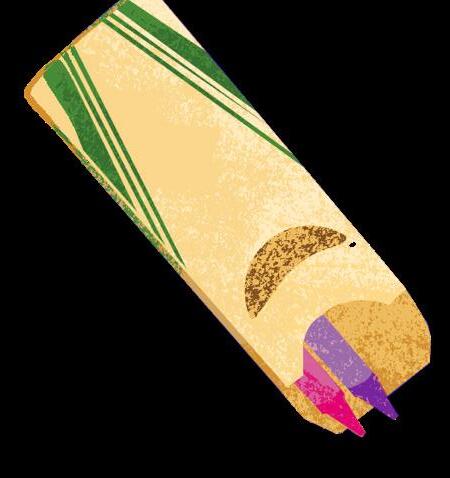

ISephora is the new sandbox.
BY ZAARA SHAFI Illustration by Emmi Wu

first dipped my toes into the world of beauty and skincare at the age of nine. As soon as my mom left to run errands, I snuck into her room and planted myself at her magical vanity. With the contents of her makeup bag laid out in front of me, Zoella’s iconic makeup tutorials playing on an iPad mini, and a luxurious black bullet of lipstick in hand, I meticulously applied a scarlet shade to my lips. Armed solely with practice in using Maybelline’s BabyLips, it’s no surprise that the final result was far from ideal—I looked more like Miranda Sings than Red–era Taylor Swift.
As a beauty–obsessed preteen in the 2010s, I quenched my thirst for makeup and skincare by secretly using my mom’s collection and
subsisting on the three products I owned. For young girls today, the situation could not be more different.
The epidemic of 10–year–old girls crowding Sephoras worldwide has set the internet aflame. But why is this such an issue? According to a plethora of TikTok storytimes by Sephora employees and customers, these girls are not the easiest of customers: Most of them, who come in search of expensive viral skin care products, often mistreat employees and leave stores in disarray. In a Vanity Fair article, a Sephora employee recounts young girls pumping foundations onto the floor and drawing on displays with lipstick.
An essential part of girlhood is the desire

to be treated as equals to adults. The controversial “Sephora Gen–Alphas" seek to embody the “perfect” female influencers they idealize, from their dietary restrictions to their beauty routines. In a 2021 study, The New York Times highlights how Instagram worsens body image issues for one in every three teenage girls. Ads and other online content glamorize disordered eating and excessive exercise, instilling a desire in women and girls to be “skinny.” By adding clear and smooth skin to our "things–women–must–aspire–to" list, body image issues in women and girls will only heighten.
Young girls look to emulate their favorite influencers from head to toe: They want to look like them, dress like them, and, of course, have
34 TH STREET MAGAZINE 14
CULTURE // STYLE

the same airbrushed skin that they have. What better way to do this than buy the very products these influencers use? Some have referred to this fixation on skincare as dermorexia, and its repercussions can be disastrous. From their tweenage years, girls begin comparing themselves to the faces and bodies they see on social media, catalyzing a vicious cycle of deteriorating self image and mental health.
Moreover, the physical effects of an over–reliance on skincare can be consequential. When it comes to skincare, the overarching mantra on TikTok preaches that more is better. Layering too many products, however, can do significant damage to the skin’s moisture barrier, which can worsen skin issues. By constantly buying
and trying new skincare products, young girls may intensify any future skin problems.
As we watch a plethora of young girls showcase their 10–step skincare routines and post “What I Got For Christmas" hauls to thousands of online followers, we have to ask ourselves: Does this signal the demise of the preteen phase? The preteen years mark a critical moment of transformation in a young person’s life. My preteen self was obsessive, chaotic, and weird (I, for one, had an entire diary dedicated to One Direction, with every fact I could find about them, from the exact minute they were born to their blood types). I wore hideous outfits to later cringe at, filled photo albums with embarrassing selfies, and tried so hard
to recreate Cara Delevingne’s heavy brow look. However, after all this time, I wouldn’t be the person I am today without my pre–teenage years. They gave me space and time to grow into the best version of myself (I threw my 1D diary away, I promise).
It is no secret that the preteens of 2024 have strayed from boy band obsessions and Rainbow Loom addictions. While it’s jarring to see a 10–year–old girl applying Drunk Elephant moisturizer in her neon pink bedroom, this is no laughing matter. Just like me, she deserves the time to enjoy her defining preteen years (even the awkward moments); the burden of obsessing over her body or skin will only weigh her down. k
15 MARCH 2024

The Galleries at the Philadelphia Museum of Art that No One Talks About
Don’t have 14 dollars for a ticket?
In 1967, Darryl “Cornbread” McCray had a crush. Many modern teenagers would meander endlessly through a tedious talking stage that takes months to develope, but Cornbread had some gargantuan balls. Using a can of spray paint, he began tagging “CORNBREAD LOVES CYNTHIA” around the streets of Philadelphia as a vehicle for his intense feelings. McCray didn’t know it then, his public display of puppy love would be the predecessor for the modern graffiti movement marked by the likes of Bas-
BY KYUNGHWAN LIM
Graphics by Emmi Wu
quiat and Banksy.
Today, McCray has since given up tagging the streets, but many continue his legacy to prop up Philadelphia’s title as the “Mural Capital of the World.” Yet, despite the city’s role as the birthplace of the art form, street art lacks a place in the Philadelphia Museum of Art. Well, indoors, that is. If you take a look outside, the nooks and crannies of the Greek Revival architecture are plastered with Rust-Oleum.
For instance, muralists have taken a
liking to the north and south ends of the museum due to copious amounts of vegetation that will keep their work from being detected. However, the south end contains an exposed wall where a single artist has flouted among the rest. As if to openly challenge the high–and–mighty art of the museum, our anonymous graffitist has placed two cheeky human–like faces on opposite sides of an ornate facade decorated by Greek sculpture and lettering. The resulting juxtaposition is comical, a visual dialogue between the
34 TH STREET MAGAZINE 16 CITY // FOCUS
worlds of “sacred” and “profane” art.
And just a few steps away, onlookers find the work of an artist I’ve dubbed Steve at the North Cliffside Path. Steve uses a particular shade of black paint so dark it absorbs the various textures of the sharp crags and the plants into a dark void. With this as his weapon of choice, Steve signs his name and grafts “FREE MICHAEL WES JOS TOVELOKE R.DOT” among other monikers onto the mossy rock. The lettering is in the '70s punk style associated with Stüssy and The Sex Pistols, a common motif in graffiti.
Yet, the most impressive collection of graffiti at the museum is located on the southwest end of the museum directly facing the Schuylkill. From its humble beginnings as a SEPTA trolley path, the Spring Garden Street Tunnel is now a
poorly maintained one–way road that’s filled with trash and flickering lights—a perfect breeding ground for street art. Although it’s probably the creepiest place I’ve ever stepped foot in, my anxiety fades as I gaze in awe at the paint–covered walls. Unbridled by the seclusion of the location, the artwork here is beautifully chaotic. The block letters of the throw–up lack structure, the color palette is almost Fauvist, and the jumbles of text don't hesitate to tower over the viewer as they go from one end of the tunnel to another. Some of my favorites among these works include a caricatured drawing of a man on fire that looks as if a Schiele self–portrait was high on copious amounts of weed.
However, the most exciting thing
the work I just described will exist in a couple of weeks. Unlike various Picassos and Rubens stored just a few hundred feet away, the Philadelphia Museum of Art doesn’t conserve or restore any of the “vandalism” on their property, leaving it to the weather or government groundskeepers to clean it up. But the blank slate they’ll leave behind will give way to a fresh generation of graffiti, with each wave yielding to the birth of the new. This is what sets the genre apart. Unlike its museum counterparts, graffiti thrives on any form of decay—whether that be the North Cliffside Path, the Spring Garden Street Tunnel, or the fading ink of its forefathers. Who knows, maybe Steve’s tags are sitting on top of where Cornbread felt love for the first

9:00 a.m. — Usual coffee of the day, this time at Stommons.
7:00 p.m. — Incredibly cold day. The type of cold that makes you NEED a ramen desperately. I decided to go to Terakawa Ramen, which never dis- appoints. 19 dollars for the best ramen I have ever had.

Day One: Girl Math Monday
9:00 a.m. — Wait in line at Stommons to get an iced caramel macchiato and a plain bagel with cream cheese. In my mind, it's free because it’s dining dollars. Girl math.
9:20 a.m. — Change of mind, going to Saxby’s; the line at Stommons is too long.
9:30 a.m. — Just paid 15 dollars for a bagel and a macchiato. My mind immediately converts this to my country’s currency. Ouch! That was expensive.
12:00 p.m. — Really wanted to eat off campus at places like DIG or Honeygrow. Thought twice about spending more than 20 dollars on a meal. Okay ... let’s go to KCECH.
The only thing good about KCECH food is the pizza. The. Only. Thing. Oh, and for the omelets you have to wait 10 minutes in line.
1:00 p.m. — Craving some dessert after lunch (also, I'm on my period). Went to CVS, and craved every bit of Reese’s peanut bu er cups (the thin ones) and the chocolate raspberry TruFru. Or should I get sea salt caramel instead?
Decided to get TruFru. It is an obsession by this point.
3:00 p.m. — Ordered a book at Amazon for a class. Modern and Contemporary Irish Drama would not be my first choice for spending 33 dollars.
STYLE
A week in the life of a penn student's credit card
BY LUIZA LOUBACK
Follow the Money Trail
Each year, Penn students shell out tens of thousands in tuition money and remain shackled to the ever–treacherous two–year on–campus living and dining scheme. But that’s not all we spend our money on. Street knows well that the bleak reality of a Penn student can only be soothed by the sweet embrace of a $7–15 daily treat— or two. Feel no shame, take no blame—we too have had our wallets run dry at the Walnut Street CVS, Lyn’s food cart, and Saxby’s 6-dollar cold brews. In honor of this month’s money issue, one of Street’s writers chronicled their daily purchases in a tell–all money diary.
12:00 favor Treat 20 dollars—it's 3:00 ing the and a ractions items of ories. 7:00 p.m. aff matoair—whip sauce and it saves
34 TH STREET MAGAZINE 18
DAY TWO: TERAKAWA TUESDAY
Day THREE: Workout wifey WEDNESday
8:00 a.m. — Hit the snooze bu on a few too many times and miss breakfast at home. Grab a quick bite at Saxyby’s again—another bagel and macchiato combo sets me back 15 dollars. Starting to wonder if this habit is sustainable.

12:30 p.m. — Lunchtime rolls around, and I'm craving something different. Decided to treat myself to sushi from Maki—a salmon avocado roll for eight dollars. Not that bad. It's a good change from McClelland sushi.
3:00 p.m. — Feeling sluggish after lunch, so I swing by the campus gym to check out their classes. Sign up for a trial session of yoga—it's free, so why not?

12:00 p.m. — of a late brunch at a trendy café downtown. myself to avocado toast and a fancy la e for dollars—it's the perfect start to the weekend.
p.m. — Spend the afternoon explor- city with friends, stopping at various shops ractions along the way. Splurge on a few new of clothing, but it's worth it for the fun memp.m. — Dinner tonight is a homemade air—whip up a batch of pasta with pesto and to- sauce from ACME. It's simple but satisfying, saves me from spending money on takeout.

Day FOUR: Tightening the belt THURSDAY 9:00 a.m. — Feeling ambitious; I decided to kickstart my day with a morning run. Realize I don't have running shoes, so I splurge on a new pair from Adidas (on sale for 54 dollars). It's an investment, right?
12:00 p.m. — Opt for a homemade lunch to-
5:00 p.m. — It's been a long day, so I treat myselftobobateafromGongChaonmywayhome. Indulge in a passion fruit yogurt with tapioca pearls for eight dollars—the perfect pick–me–up (kinda expensive though).
day to save some cash. Whip up a simple salad withingredientsfromthefridge—it'snotthemostexciting meal, but it gets the job done.

10:00 a.m. — Needed to get an extra large Dunkin' coffee before my art history recitation. Here’s to an excruciating one hour.
2:00 p.m. — Spend the afternoon catching up on readings and chores around the house. It's not the most exciting way to spend a Friday, but it's satisfying to check things off my to–do list.
6:00 p.m. — Dinner tonight is a Philly cheesesteak at Greek Lady. It’s huge, so the 14–dollar price makes sense. If you’re not that hungry, the halal cart in front of Gregory College House is the best.
19 DECEMBER 2023

10:00 a.m. — Spring break is coming. My boyfriend and I have zero plans. Had a psychotic crisis and decided to go to the most expensive place on earth. Yes, you got it right if you said Disneyland. Splurge on park tickets, car rental, Airbnb, and airfare. Disney adults, here I come.
I am broke now.













I would rather become a stripper than sell out in the way Vivek Ramaswamy has.




































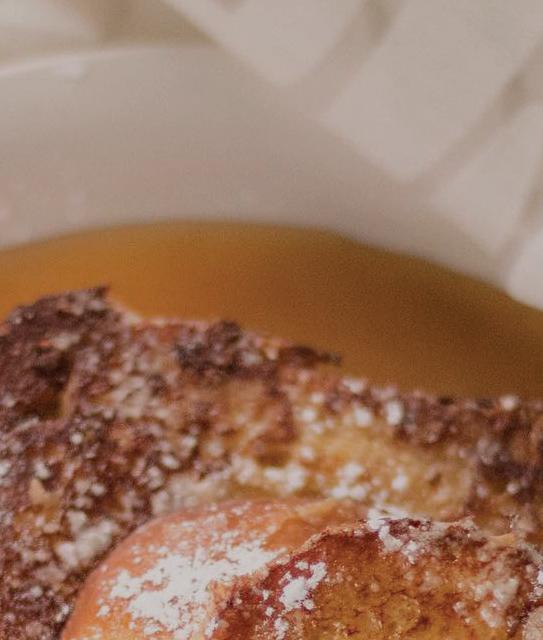


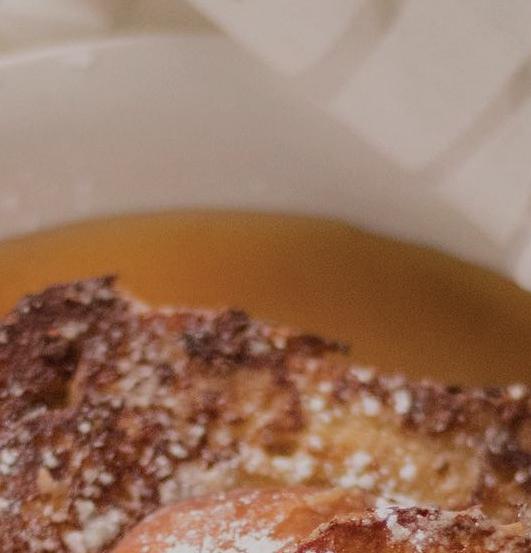











34 TH STREET MAGAZINE 20
springfield distributor beer Post finals pre game CALLS FOR A We’ve got THE BEER FOR your holiday party! Get beer delivered for ST. PAT’S DAY PARTIES 40th & Spruce St., University City • 215-382-1330 • copauc.com WEDNESDAYS 1/2 PRICE BURGERS 11:30AM - 4PM SATURDAY & SUNDAY BRUNCH 11:30AM - 3PM BLOODY MARYS 40th&SpruceSt.,UniversityCity•215-382-1330•copauc.com

Pu ing Money Where Your Mic is: Grooves About Greenbacks
In the tumult of midterm season (which is to say, anytime after the second week of classes) Penn students need motivation. What be er way to fuel a study session or shift at work than with music pointing toward the ultimate end goal? According to some, it’s not love—Valentine’s Day is over.
`
“Money” — Pink Floyd
One of many songs to proudly inherit from your dad’s music taste, “Money” starts with a unique in-
tro: literally, the sound of money. After the distinctive sound of an old cash register comes a splicing ofingnoises,includingtheclinkofshinycoinsandthetearof paper. They make up a seven–part loop that gradually melts into one of the best basslines in ‘70s rock. Then the song’s lyrics come in, satirizing theitylifestylesoftheobscenelyrich.“I’minthehigh–fidelfirst–class traveling section / And I think I need a
Lear jet,” David Gilmour sings.The best line,though, might come near the end: “Money / So they say / Is
the root of all evil today,” it declares. “But if you ask
for a rise / It’s no surprise that they’re giving none away.” In true Pink Floyd fashion, add in about three minutes of instrumental—saxophone and guitar so-
los delivered by Dick Parry and Gilmour, respectively—and you’ve gotyourself a classic.
Street’s curated list of five of the best songs about money—a penny for our thoughts.
BY JULIA FISCHER GRAPHIC BY INSIA HAQUE
Not altruism either: “Changing the world” is much harder than your college admissions essays might’ve assumed. The answer is cold, hard cash—but not according to all of these tracks, which provide a variety of outlooks. All that gli ers is not gold, but these songs sure are.
` “Money Trees” — Kendrick Lamar, Jay Rock
We encounter another iconic loop in Kendrick Lamar’s 2012 hit “Money Trees,” with one of the most creative uses of a sample you’ll ever hear. The otherworldly instrumentation that repeats throughout the track is a snippet of alternative band Beach House’s "Silver Soul." Producer Dahi reversed the sample and addeddrumstoittocreateastellarmotifthatrepeats throughout the track. In terms of the song’s storyline, though, “Money Trees” couldn’t be more different from “Money.” In contrast to the nameless one–percenter protagonist in Pink Floyd’s lyrics, Lamar raps about growing up in poverty in Compton, Calif. He discusses “dreams of living life like rappers do,” even while tempted by the temporary payout—emotional and financial—of sex, drugs, and crime. Economic stability is elusive, gang violence abounds, and the phrase “ya bish” is all too catchy. Money might not grow on trees, but young Kendrick was determined to plant his own and turn his circumstances around. “Money trees is the perfect place for shade,” Lamar sings, “And that’s just how I feel.”
MUSIC

"Can’t Buy Me Love" — The Beatles
Ah, The Beatles, with their mop–top bowl cuts, awk- ward grins, and starstruck crowds of fangirls. "Can't Buy Me Love" is a short but sweet tune off their 1964 albumAHardDay’sNight , combining catchy chorus- es with punchy drums and guitar. For a band aimed at worldwide success, Paul, John, George, and Ringo express a surprising detachment from material riches. With the realization that you can’t purchase a re- lationship at the local five and dime, cash becomes extremely expendable: “I’ll buy you a diamond ring my friend / If it makes you feel alright.” It’s easy to understand the track’s romantic appeal, as it places love above all else; “I may not have a lot to give / But what I got, I’ll give to you,” Paul McCartney sings. (Later on, looking back on The Beatles’ vacation in Miami after their first American tour, he would joke, “It should have been ‘[Money] Can Buy Me Love,’ actually.”) Regardless, once you know the words, it’s a song that bounces around your head for hours … and you’re not upset about it.
“Money, Money, Money” — ABBA
“Money, Money, Money” is ABBA's contemplation on the merits of becoming a trophy wife. What else is a girl expected to do in “a rich man’s world”? The piano and synthesizer that dominate the sound create a sense of drama, and the song is as much a relatable rant as it is the pinnacle of disco pop. Any college student can empathize with working hard, paying the bills, and in the end, as Anni–Frid Lyngstad sings, feeling “there never seems to be / A single penny left for me” (first years, if this doesn’t strike a chord yet, just wait). Taking into account that it wasn’t until 1974, just two years before this song’s release, that women in the United States gained the right to open a bank account on their own, “Money, Money, Money” is more than just a would–be gold digger’s anthem. “Ain’t it sad?”
Bills"
—
ABBA’sdebateonragsandrichesfindsadetermined and sassy answer, courtesy of legendary girl group Destiny’sChild.On"Bills,Bills,Bills,"welistentothe taleofawomanwhoseboyfriendisabittoocomfortableafterthehoneymoonphaseatthestartoftheir relationship and is starting to take far more than he gives.He’sprovinghe’s“ascrub…/Whodon’tknow what a man’s about.” What are they saying a man’s about? Earning money, or at the very least being dependable.The lush vocal harmonies that abound on the track—especially on the “so” in “so, you and me are through”—are so good we’re convinced the girlfriendmeansbusiness.Andofcourse,thesnappy lyricism hits its peakwith a greatpun:“Canyou pay mybills?/Canyoupaymytelephonebills?/Doyou paymyautomo’bills?”Iftheanswerstothesequestionsareno…Destiny’sChildhasbadnewsforyour romance,andgoodnewsforyourwallet.
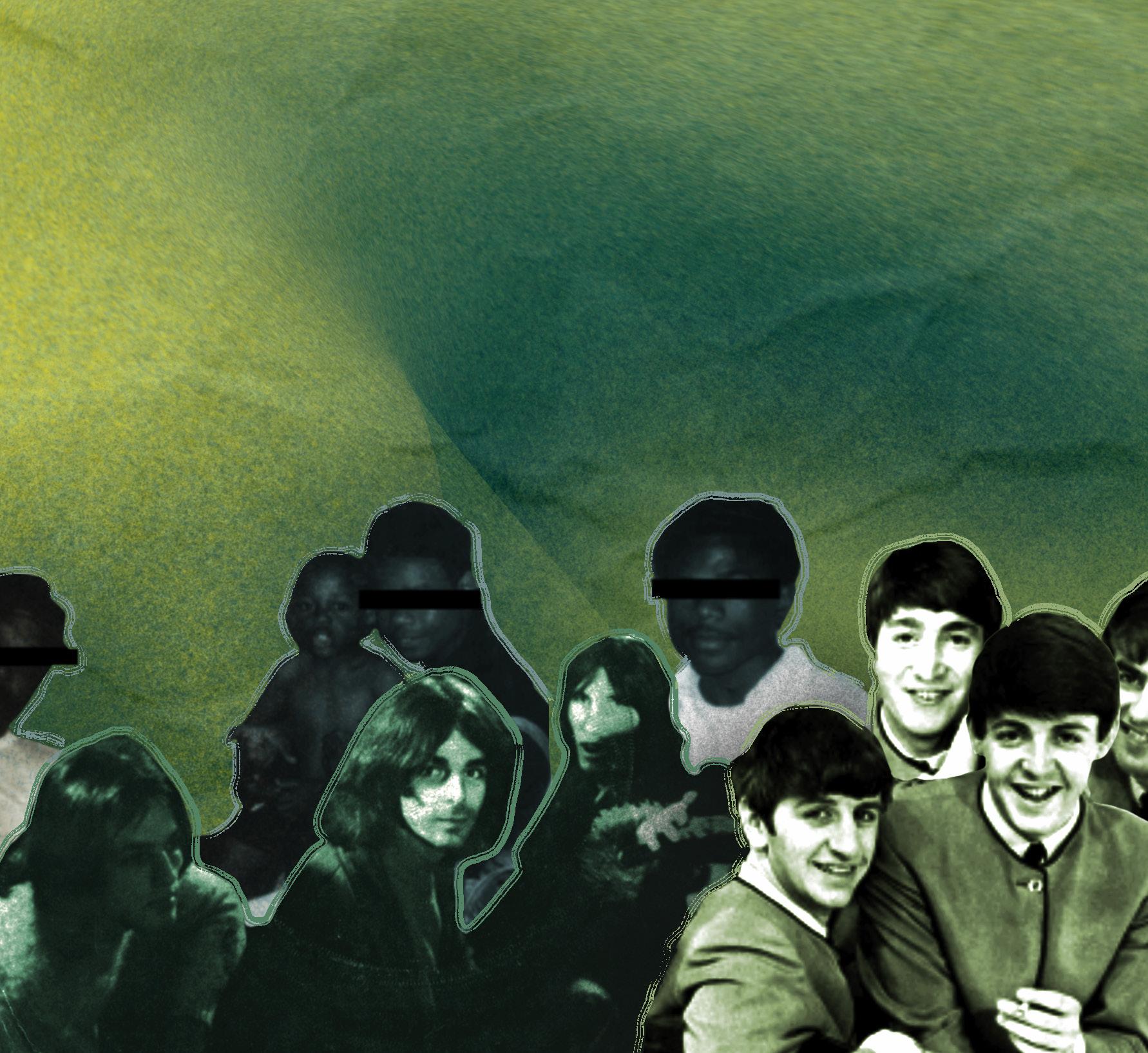
“Million Dollar Man”
—
Lana Del Rey
stuffed wallet and a lover who “look[s] like a million dollar man,” Del Reyteaches us there are other, more devastating ways to be bankrupt.The masterof double meanings still sings, “Why is my heart broke?”
`
`
Finally, we have the tenth track on Lana Del Rey’s debut major–label album, BorntoDie—a grandiose ode to a “Million Dollar Man.” The song is relatively slow in terms of tempo, but Del Rey’s low vocals, matched with jazzy piano and sweeping violin, build to a chorus that’s as heartwrenching as it is cinematic, especially near the three–minute mark. The lyrics describe a relationship that, on the surface, seems glamorous and easilylives up to the standards we received from Destiny’s Child. Del Rey is with this man for two main reasons. In a reference to Elvis Presley’s cover of “Blue Suede Shoes,” it’s “one for the money / and two for the show”—which is to say, for his wealth and for the thrill. But the man she describes is “dangerous, tainted and flawed.” “You’ve got the world, but baby, at what price?” she asks, suggesting that money isn’t everything. As nice as it is to have a 34 TH STREET MAGAZINE 22
` "Bills, Bills,
Destiny’s Child
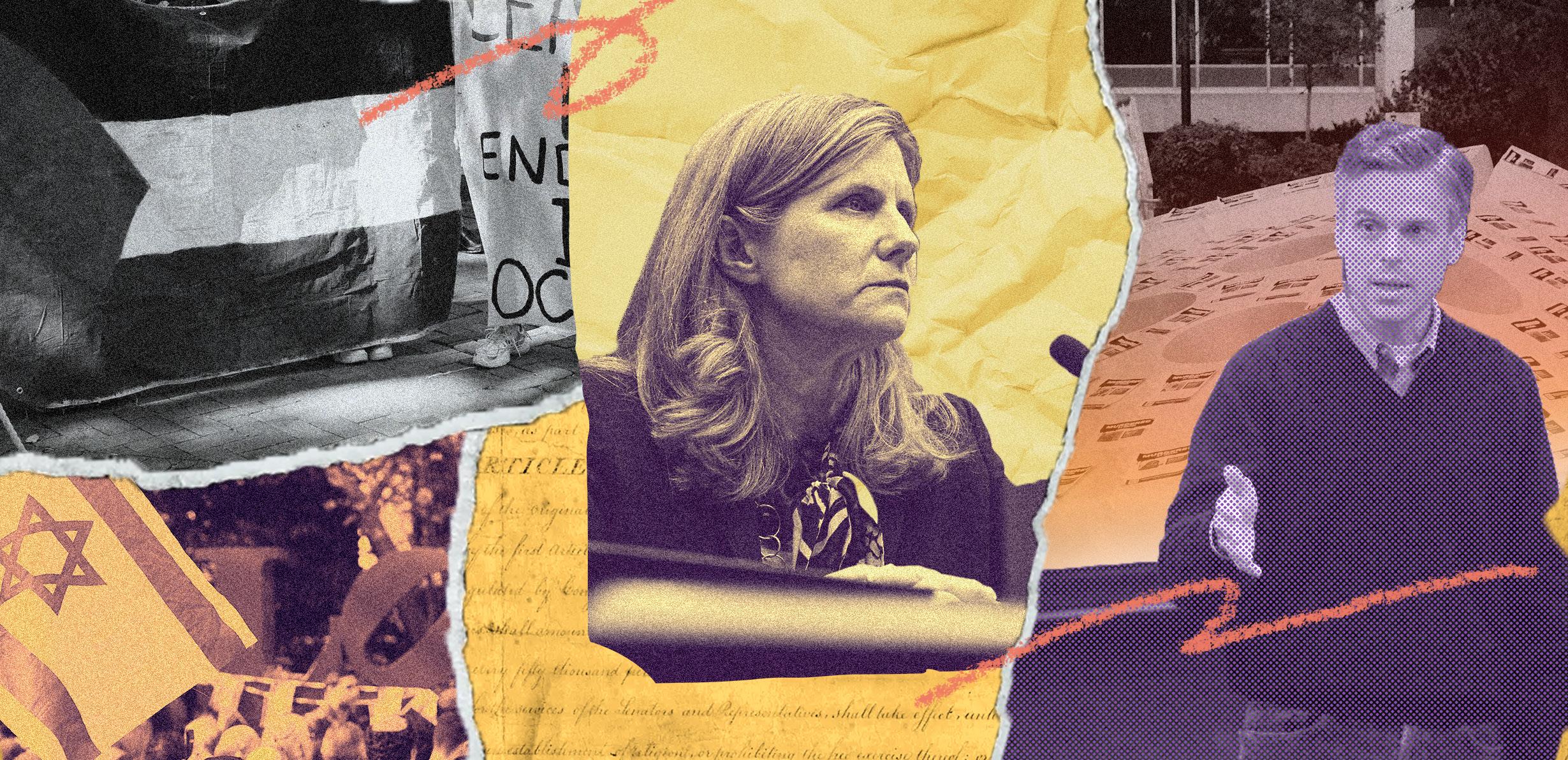
FEATURE
Donors Rule Everything Around Me
When money talks, professors are silenced
BY HANNAH SUNG AND JULES LINGENFELTER
GRAPHICS BY EMMI WU
Early in the morning on June 16, 1915, professor Sco Nearing received notice of his dismissal from Penn. “As the term of your appointment as assistant professor of economics for 1914–1915 is about to expire,” disclosed the le er from the Provost, “I am directed by the trustees of the University of Pennsylvania to inform you that it will not be renewed."
Nearing, in his autobiography, wrote, “I was fired without previous notice, without charges, without a hearing, without recourse, from a job I held for nine years.” His crime? Expressing anti–Capitalist sentiments and ad-
vocating for child labor laws. Penn fired the popular professor, whose lectures garnered the largest enrollment in any class at the time.
Penn's Board of Trustees at the time—which included bankers, corporation lawyers, and a partner at J.P. Morgan—had been troubled by the economist’s research. The Wharton School alumni commi ee insisted on firing faculty members who “tended to arouse class prejudice,” including Nearing, who they claimed reached “fallacious conclusions.” Nearing’s dismissal impacted the role of tenure at Penn and spurred nationwide debates surrounding free speech.
$$$$$
Over a century after Nearing’s expulsion, the state of academic freedom at Penn remains tenuous.
The spotlight on Penn began in late September 2023 with the Palestine Writes Literature Festival controversy and immediate backlash from donors. Tensions further escalated after the Oct. 7 Hamas a acks, the ensuing war, and former Penn President Liz Magill’s highly publicized response. In a series of statements, Magill sought to appease students, alumni, and donor concerns regarding rising antisemitism on
23 MARCH 2024
campus. Her wavering response was deemed insufficient by Penn donors, many of whom withdrew funding and called for Magill and former University Board of Trustees Chair Sco Bok to resign.
Beyond Penn, the national scrutiny surrounding claims of rising antisemitism on college campuses mounted an investigation by the United States House Commi ee on Education and Workforce. Magill testified in front of the commi ee on Dec. 5, 2023. Following a widely–circulated clip, Magill was criticized for her responses to questioning by Rep. Elise Stefanik (R–N.Y.), who asked if individuals who call for the genocide of Jewish people violate Penn’s policies or code of conduct. Magill called it a “context–dependent decision.” Soon after the hearing, on Dec. 9, Magill and Bok resigned from their respective positions.
Magill’s resignation and the events of last fall have placed Penn at the forefront of debates about University and donor–led threats to academic freedom. For example, Penn initially denied progressive Jewish student group Penn Chavurah's request to screen the movie Israelism on Nov. 28, 2023. Just over a month before that, 1965 Wharton graduate Ronald Lauder wrote to Magill demanding that no students at the Lauder Institute be taught by any instructors who were involved or supported the Palestine Writes Literature Festival. But these free speech conflicts didn’t end after Magill’s resignation.
$$$$$
On Feb. 1, Annenberg School for Communication lecturer Dwayne Booth, who publishes political cartoons under the name Mr. Fish, came under fire for a series of highly controversial images intended to criticize the Israeli government. The public a ention “started when the Washington Free Beacon released an article accusing me of antisemitism,” he explains.
Despite the comics being published months earlier, Interim Penn President Larry Jameson did not release a statement regarding Fish’s work until after the Washington Free Beacon’s accusations against the political cartoonist. Jameson condemned the cartoons, describing them as “reprehensible, with antisemitic symbols, and incongruent with our efforts to fight

hate,” further stating that they “do not reflect the views of the University of Pennsylvania, or me personally.” Jameson’s prompt response comes among Penn’s many efforts to rehabilitate its public image, reflecting a pivot from Magill’s past six months of turmoil on campus.
Fish has been teaching at Penn for ten years and creating political cartoons since the ‘90s; he’s dealt with criticism—and hate—for most of his art career. But this latest incident is the first time his artistic work has elicited a response from the institution. Even if his art is extracurricular, it is now being characterized as a representation of Penn as an institution. Fish acknowledges that the reaction his work has garnered no longer affects just him.
“[Jameson] released his statement, unfortunately giving a certain amount of credibility to the Washington Free Beacon’s assessment of my work,” Fish says. “These were misstatements because they’re just inaccurate and tend to justify the shu ing down of voices rather
than the expansion of conversations and debate, which is what should be happening on college campuses.”
Despite Jameson’s highly public statement, Fish reports receiving support from students, alumni, and his colleagues at Annenberg. Although Fish has found himself in a complicated situation, he admits that it’s exactly what he is trying to teach his students. “It’s the subject of our conversation in class: How provocative artist communication can be and how it can be misconstrued to be something else. So when this broke, it’s a real–life organic example of stuff we’ve been talking about theoretically. The class is really thrilled,” he says.
However, the condemnations of Fish run deeper than Jameson’s statements; Fish has since received death threats and calls for resignation. He even chose to move one of his classes temporarily online after its time and location were made public, fearing for both his and his students’ safety. While Fish has not received
PRINT // LEGACY 34 TH STREET MAGAZINE 24
any disciplinary action, he believes Annenberg would be willing to support him. But the controversy that has erupted around his work—or rather, the threats he’s received in response to his work—threatens the intellectual and physical safety of Penn students and faculty.
Following the a acks on Fish, the Penn chapter of the American Association of University Professors released a statement condemning both the “targeted harassment of Annenberg faculty Dwayne Booth” and “Interim President Jameson’s dangerous and unwarranted response,” citing both as threats to academic freedom. AAUP–Penn pointed to the University’s own handbook, which protects extramural speech of all faculty, and that any disciplinary action towards Fish would result in the justification of a formal investigation by the group.
The AAUP’s stance on the ma er was clear: “The fundamental duty of the university administration in a time of war and political conflict is to protect academic freedom.”
$$$$$
The AAUP has a long history with academic freedom. The association was founded in 1915, the same year as Nearing’s firing; 32 of its charter members were Penn faculty. The forces that fired Nearing and led to the formation of the advocacy group are the same forces at work targeting Fish—donors, politicians, and the public that read fear mongering accounts of campus
melee.
In the decades following Nearing’s dismissal, events such as the Second Red Scare took hold of college campuses. Around a hundred professorships were terminated in the mid–20th century in the wake of the Scare. Political subversives that caused mass hysteria have been and continue to be a recurring phenomenon, even over 100 years after Nearing’s firing.
Have we dawned on a new era of censorship? According to the Foundation for Individual Rights and Expression, a.k.a. FIRE, we just might have. Greg Lukianoff, current president and CEO of FIRE, states on FIRE’s website that there have been over “1,000 campaigns to get professors punished” by their adversaries in the past decade; almost one–fifth succeeded in ge ing them fired, which is noted to be “nearly twice the number estimated for the Red Scare.”
FIRE claims to be unflinchingly nonpartisan, not who is “right or wrong.” They have explicitly refrained from taking a position on the Israel–Palestine conflict. However, the organization recently stated, “FIRE has been troubled to see some college leaders react to protected speech and peaceful protests with calls to prohibit speech they view as inflammatory or even to ban student groups because of their viewpoints.”
Joseph Cohn, a University of Pennsylvania Carey Law and Fels Institute of Government alumnus, worked for FIRE as its previous legislative and policy director for the past 12 years until

he began his bid for Congress in New Jersey’s third congressional district this past December. While at FIRE, Cohn noticed an alarming spike in people contacting the nonprofit regarding freedom of speech and academic freedom on campuses.
In the past, students would be up in arms and at each other's throats, but their main enemy was the man—the man being the administration. “Students would rally behind all students, even if they were their political adversaries, if the administration tried to shut them up, being a collective force for each other,” Cohn says. But in the last decade, students have been vying for administrators to join their side of the fight and punish their opposition. The implications of this development are concerning—by stifling conversation, these conflicts become a pissing contest beyond solely debate, inviting money and political influence into the equation.
As a private institution, Penn is not constitutionally protected by the First Amendment. But, thanks to Penn’s wri en policies in the Faculty Handbook and Pennbook, this liberty is still afforded to us. In theory, these rights are protected for students and faculty, but recent events have raised doubts over their validity in practice.
$$$$$
The combined effect of recent turmoil on Penn’s campus and pressure from donors has mounted fears for academic freedom inside and outside the classroom.
Following the University’s initial response to the Palestine Writes Literature Festival and the Oct. 7 Hamas a acks, the Chairman of the Board of Advisors of the Wharton School and Penn alumnus Marc Rowan published what became one of the most publicly stated funding withdrawals in an open le er: “I call on all UPenn alumni and supporters who believe we are heading in the wrong direction to ‘Close their Checkbooks’ until Magill and Chair Sco Bok resign,” Rowan published on Oct. 14, 2023. Rowan’s call to action triggered similar donor withdrawals from notable Penn alumni, like Jon Huntsman Jr. and Ronald Lauder.
“There’s this enormous gap between what the world thinks Penn is like—or what the world is coming to think—and what actually is the case,” says Ian Lustick, Professor Emeritus and Bess W. Heyman Chair in the Political
25 MARCH 2024
Science Department at Penn. He’s taught a course on the history of Israel and Palestine at various universities for decades, including this past fall semester at Penn. Amid the controversies on campus, Lustick and his students found themselves thrust into a real–time analysis of the events. “There was not a single moment of distress in the class or tension, but there was intense discussion and questioning.”
There was, however, a dissonance between the experience Lustick describes within the classroom, and the one privy to the public. “While these students reported that there were tensions on campus, they did not report feeling afraid or unsafe. But what they did say is that they were receiving frantic phone calls from family members, journalists, and friends at other universities, who had formed an impression that things were absolutely haywire when it came to this,” he says.
The severity of the situation lies in donors’ a empts to further increase their power and control over how our academic institution operates. “This is not about somebody who has some money and won't give $50,000 if their son doesn’t get accepted into the University,” Lustick says. “We’re talking about demands for the disciplining of masses of students, demands for the adoption of a particular catechism on a very important issue, for the ve ing of syllabi, for control over hiring decisions, and over the creation and destruction of particular departments. This is absolutely beyond the pale.”
There seems to be a conflation between money and power, and the role of donors has further distorted that dynamic in the last six months. Penn is not isolated from market forces.
What happened last semester shows the direct consequences of when money is weaponized within the academic sphere. When universities place donors’ demands above their mission to promote academic freedom, the integrity of our learning institution is compromised.
What happened last semester shows the direct consequences of when money is weaponized within the academic sphere.
Lustick echoes FIRE’s sentiment and believes that we are on a new Red Scare era. “I would compare the pressures that people are under to McCarthy’s period in the ‘50s in the United States,” he says. “People went into hiding, essentially intellectually, and their careers suffered. That’s the kind of situation which we’re now facing.”
In reaction to Fish’s political cartoons, Lustick states, “I don’t want to punish the person that I may not agree with … I don’t expect all faculty members to agree with me either about my extracurricular views, or even my curricular views. That’s not what I’m here for. I’m not here to agree with everybody.” He further argues that Fish acted within his right of freedom of speech and that any calls for resignation and disciplinary action are unjustified. For a university to function, it must be able to acknowledge the free-
dom of its participants to pursue academics without fear of consequence.
$$$$$
While faculty solidarity in cases of academic freedom is largely widespread, the AAUP and its constituent faculty have no bargaining power. Andrew Vaughan, an assistant professor for biomedical sciences at the School of Veterinary Medicine and a member of AAUP–Penn, recognizes the limitations the group has. “We're limited to trying to raise concerns and advocate for changes without any ability to actually institute those changes themselves,” he says.
Part of this advocacy involves the role of the Faculty Senate. “Over the last couple of months, I feel as though the Faculty Senate executive commi ee has really tried to step up and similarly champion the same concerns of AAUP,” Vaughan says. The Faculty Senate is Penn professors’ one avenue to have a say in University governance. The organization is only made up of tenure–track faculty, while the AAUP chapter is made up of faculty of all levels. In a statement on its website, Penn’s Faculty Senate declared solidarity across rank, especially for those “affected by recent efforts of intimidation.” The statement reads, “Let us be clear: academic freedom is an essential component of a world–class university and is not a commodity that can be bought or sold by those who seek to use their pocketbooks to shape our mission.”
There has been speculation among the Faculty Senate itself about the extent of its role. Vaughan recounts an anecdote that he heard about Faculty Senate representatives at the

PRINT // LEGACY
Board of Trustees Meetings not being allowed to speak. “We're actively trying to engage more with the Board of Trustees, and we'd like to try to get ourselves more of a seat at the table,” Vaughan says. Penn’s faculty, Vaughan adds, were blindsided by the fact that the administration can “essentially [do] whatever they like within their own bylaws. They can completely ignore any language.” When viewing Penn as a workplace, beyond an academic institution, these standards are horrific.
AAUP–Penn works to dismantle the hierarchy of faculty. The gift of camaraderie and cross–department interaction is important in any workplace—the ability to talk among employees about shared experiences and grievances, and bring these to an employer. “It’s a missed opportunity; we’re all so siloed in our own li le worlds,” Vaughan says, remarking how before AAUP, he had never interacted with anyone in other departments, like English or history.
Though Vaughan himself hasn’t been personally affected in his ability to teach, he refers to his colleagues as comrades, stating, “Have I seen it impact colleagues and professors across campus? Absolutely, and I am concerned about it.”
In December 2023, the Pennsylvania legislature halted funding to the School of Veterinary Medicine—the only state–funded veterinary school in Pennsylvania—and the Penn Medicine Division for Infectious Diseases. This decision was in response to allegations of antisemitism on campus.
“I think those of us in life sciences and medical sciences sometimes take it for granted that these outside forces aren't going to have as much influence on us,” Vaughan reflects.
This decision underscores how the reach and influence of money in academic institutions knows no bounds.
$$$$$
How did Penn get out of the McCarthy–era trenches to where it is now? To answer this, we need to look back at Nearing’s martyrdom as a cautionary tale. Free speech and academic freedom, which lend themselves to a quality education, all hinge on faculty support. Decreasing tenure provisions, denial of due processes for

some faculty, and lack of transparency from the administration affect everyone at Penn. But things don’t have to be bleak.
“The principles of free speech are evergreen,” Cohn says. “It’s easy to reject notions of free speech when you're in charge. But on a long enough timeline, those tables turn … people on the receiving end start realizing they need to have more consistent practices and policies. Most people don't accept being silenced.” Cohn a ributes a short–term worsening scenario to the pressure on the University to respond to Gaza. The lines for what is protected—speech, protests, controversial speakers on campus—and not protected—targeting groups of students, and of course violence— are blurred. “This moment will eventually pass,” Cohn assures.
As well as normalizing disagreements without fear of retribution from outside influences, supporting faculty is key. There are problematic implications in relying on contingent faculty, especially when teaching controversial topics. Strategic self–censorship becomes the norm, and job precariousness supersedes academic integrity. Penn’s administration ought to prioritize protecting faculty in exercising their autonomy in teaching and researching. Expanding the accessibility of the tenure track can guarantee both academic freedom and economic stability—something a majority of Penn’s faculty lacks.
“Trustees hold the ultimate authority to ensure colleges focus on truth–seeking, not truth–dictating,” Lukianoff writes on the FIRE website. “A top–down, father–knows–best mentality is
absolutely no way to support the next generation of free thinkers. Students and faculty deserve the freedom to experiment with different perspectives and explore entirely new ways of thinking without the college claiming to have done all the thinking for them.”
Moreover, Penn’s actions need to accurately reflect its academic code. “At least as it relates to academic freedom, very few things we've been pushing for so far are actually new. It's simply following the rules that already have been codified,” Vaughan says.
$$$$$
In the same le er calling for donor withdrawals from Penn, Rowan professes, “UPenn faces a choice between excellence, pursuit of truth, open inquiry, expression, and learning to think and challenge ideas, on the one hand, and social engineering and advocating and imposing a particular political agenda on the other.” Perhaps in Rowan’s own hypocrisy, he diagnoses the issue of academic freedom itself: Penn is first and foremost an academic institution, not a business. Its priority should lie in protecting faculty, staff, and students in our pursuit of knowledge. The integrity of academic freedom is not for sale. k
The integrity of academic freedom is not for sale.
25 MARCH 2024
Budgeter? IHardlyKnowHer!
Unlike dollar bills, financial advice seems to be growing on trees.
BY KATE RATNER
Illustration by Insia Haque
 LEGACY CULTURE STYLE
LEGACY CULTURE STYLE

S2023, comedian Lukas Ba le posted a video to TikTok sharing his in-and-out list for the new year. “Quiet luxury is out and loud budgeting is in,” he claims. Loud budgeting, according to Ba le, encourages transparency surrounding one’s choice to not spend money. “It’s not ‘I don’t have enough,’ it’s ‘I don’t want to spend.’” Ba le is not the first influencer to propose a shift towards financial transparency among Generation Z, however. According to CNBC, the hashtag #FinTok has amassed over 4.7 billion views on TikTok, providing online spaces for users to share snippets of their financial experiences.
The recent push to spark conversations about personal finances, budgeting, and money management stems from generational gaps
jority of Generation Xers, millennials, and Gen Zers grew up discussing household finances, most baby boomers surveyed did not. The rise of FinTok and other social media finance–based content suggests that it’s becoming less taboo to discuss money openly. We collectively dwell on our complex relationships with personal finances … so why not talk about it?
Some TikTok influencers are embracing loud budgeting to the fullest extent, sharing their personal finances with not only their peers but with the entire internet. “Payday routine” videos document influencers, across ages, salaries, and professions, breaking down their bi–weekly paychecks. Often, these videos show the exact amount of money in the paycheck and how much is being allo ed to the influ-
Users can browse thousands of payday routine videos to find an influencer whose salary, expenses, and investments are similar to theirs: from a 21–year–old making $40,000 per year to a 26–year–old paying off $31,000 of debt, to a 30–year–old making $111,000 per year. Payday routines represent an array of financial experiences: single and dual incomes, debt and debt–free, part–time and full–time, financially independent and not.
Lexi Larson, a 27–year–old lifestyle influencer based in Denver, is the matriarch of financial transparency and loud budgeting on TikTok. Larson’s content has a li le something for everyone: get–ready–with–me videos, product reviews, work–from–home vlogs, and, of course, payday routine videos. Since Larson quit her corporate advertising job to start her
34 TH STREET MAGAZINE 28
PRINT
STYLE

own clothing line, she’s maintained transparency about her finances and the precarity of self employment.
In March 2023, Larson posted a video breaking down her biweekly paycheck of $2,004 that has since gained over 9 million views. In the video, Larson sets aside a portion of her earnings to pay her credit card bill, leaving her with insufficient money to set aside for her other expenses. “I’ll probably have to take money out of my savings to cover my expenses for the next couple weeks,” Larson admits. The rawness of Larson’s content resonates with her audiences, as per the response to her viral payday routine video. One user commented: “It’s so refreshing to see someone [whose] payday routine is exactly like mine.”
Loud budgeting is only a morsel of the financial wisdom being shared across social me-
dia. Some influencers have dedicated their entire platforms to sharing money management advice. Users can now turn to the TikTok search bar to answer burning financial questions like “Where should I invest?”, “What credit card should I use?”, and “What the hell is a Roth IRA, and why do I need one?”
Vivan Tu, known as @yourrichbff on TikTok, is an ex–Wall Street equity trader turned financial literacy champion. Tu has gained over 4.5 million followers across Instagram and TikTok for sharing advice for users in all stages of their financial lives. Some of Tu’s most viewed videos include tips for negotiating extra pay at a new job, cheap flight hacks, and how to avoid being scammed during tax season.
In an interview with CBS News, Tu reminds her audience that it’s okay to start small in the world of investing. “You can literally go to an
online broker and sign up with as li le as one dollar and buy fractional shares of an ETF [exchange, trade, and funds] that tracks the broader stock market,” she says, “and with a dollar you can be invested in the entire stock market … it’s essentially like being able to buy a huge bag of Halloween candy instead of buying a bag of chocolates and a bag of gummies and a bag of … whatever sweets. You get a whole pot—a ton of different stuff—for a dollar.”
It’s no secret that managing personal finances is not a walk in the park. However, FinTok, the loud budgeting movement, and social media’s embracing of financial transparency is finally countering the age–old advice that finances are meant to be private. Maybe it’s time we throw in the towel on money myths and admit that yet another meal out is not in the cards.
29 MARCH 2024
PRINT
 LEGACY
LEGACY
Consumers Aren’t Dumb; They Are Deprived of Access.
Popularity and profitability in film are not at odds with artistic merits.
The origin of film lies in its accessibility to the masses.
From 1905 to 1908, theaters were dubbed "nickelodeons" due to their cheap five cent admission price. For working class individuals who couldn’t afford the higher class entertainment of live theater, films provided a way for the masses to appreciate art and entertainment. Gradually, as films became more and more popular across the social classes, distinctions in film emerged to establish its validity as an art form: arthouse, Oscar bait, indie, blockbusters, knockoffs.
Now, record–breaking box office sales, a plethora of multi–billion dollar franchises and expansive fandom communities across all social media platforms prove just how important films are to the economy and society.
The Marvel Cinematic Universe has been the poster child in developing a profitable franchise. Its success, totaling $29 billion across 33 films, has spawned many elaborate multiverse franchises. According to the Harvard Business Review,
Marvel’s success in 2019 was due to its ability to constantly challenge the conventions of the superhero genre, hiring a diverse array of talent and specialties to contribute to its films. Additionally, their signature storytelling techniques like Easter eggs and foreshadowing kept audiences constantly engaged for the next film.
The numerous Marvel fan communities that meticulously analyze their films, discuss theories, and produce fan works are in lockstep with Marvel’s artistic achievement. Expert fight scene choreography compounded with CGI accent already tense storylines. Key Easter eggs show forethought and planning across several writers. Franchise, in this sense, doesn’t equate to a lack in artistic merits.
However, Disney franchises have also dominated prime theater showing times, and in effect unfairly eliminated any space for other films to showcase their craftsmanship.
Quentin Tarantino, established director of Pulp Fiction, Inglourious Basterds, Kill Bill, has expressed frustration over Dis-
34 TH STREET MAGAZINE 30
BY FIONA HERZOG FILM & TV
CULTURE FILM & TV

ney utilizing its power to run Star Wars in cinemas longer than they planned, resulting in his own film being shut out of the theater. Whenever Marvel films are released, they easily fill all the prime time slots in a theater, resulting in smaller movies gaining very limited visibility.
Yet as of 2024, the MCU is a shell of what it used to be. Recent criticisms focus on over–saturation with constant movie and TV show releases, stale and repetitive plotlines. Poor effects due to the extreme time constraints and working conditions imposed on the VFX artists have also muddied the franchise’s reputation.
Is the continued profitability of films tied to a continued decrease in quality?
No. It isn’t impossible for film made outside of the establishment to bring in revenue to shine in this economy and movie climate. Audiences have the capacity to recognize and support film as an art form.
Last year, A24 productions The Whale and Everything Everywhere All at Once earned eighteen Oscar awards, six of them belonging to the top categories of Best Picture and Best Director.
In a highly bureaucratic industry, where most projects are modeled after past billion dollar franchises, A24 succeeds with a smaller budget by taking risks with their talent. The executives believe in their artists' ability to produce quality work by allowing them creative freedom. As a result, they have produced films that truly resonate with the audience and at the same time secure financing for future projects, as was the case with Everything Everywhere All at Once’s success. Its $143.4 million in box office revenue could finance multiple A24 films with budgets of $15–20 million.
This financial model, intertwined with A24's brand ethos, has allowed for its talent to succeed both creatively and financially even beyond the studio. Indie
director Greta Gerwig directed Barbie , the biggest film of 2023 (grossed $1.446 billion at the box office). Gerwig made her initial debut as a solo writer and director with Lady Bird, a film distributed by A24. It obtained the Best Picture Oscar nomination on a $10 million budget. Through her successes with Lady Bird and Little Women , she has gained recognition for producing poignant films on the female experience. As a result, she was given the opportunity to produce the commercial and critical hit Barbie
In spite of the film’s larger budget,and the necessity to balance profit, merchandising, and audience expectations of Gerwig as an artist, Barbie still succeeded across multiple fronts with little sacrifice. It was the highest-grossing movie in the domestic box office of 2023. Toy sales shot up 25% in the two months following the film’s release compared to the same time period of the previous year. Additionally, women around the world giddily embraced femininity, unabashedly dressing in hot pink when going to the theaters. Many more cried at America Ferrera’s monologue acknowledging their unspoken struggles.
The successes of Gerwig, Everything Everywhere All at Once , and more prove that artistic films aren't lost on audiences. Films that resonate with audiences have the potential to be successful. Instead of blaming the audience’s illiteracy, we should pay closer attention to large corporations' unfair advantages and preventing consumer access to a diverse array of films.
Ultimately, it is all the more important for studios to consistently support creatives who are taking storytelling risks which capture the human experience. After all, it is film’s root in democratic entertainment that makes it succeed as a medium in the first place.
31 DECEMBER 2023
LEGACY
ART

Isaw the best minds of my generation destroyed by madness, starving hysterical naked”
– Allen Ginsberg, “Howl”
Art is Dead. andCollegeKilledIt!
The rising cost of higher education has sacrificed the creativity of our generation.
BY NORAH RAMI
GRAPHIC BY ANISH GARIMIDI

In 1943, poet Allen Ginsberg entered the halls of Columbia College, where his fellow students would change the trajectory of his life, and in turn, the American poetic canon. Shrouded in their Ivy League blues, William Burroughs, Allen Ginsberg, and Jack Kerouac, along would their friends, would experiment with drugs, get in trouble, wax philosophic, and engage in the personal exploration that would become known as Beat culture.
In those years, college tuition at Columbia University was around $650, which accounting for inflation, is equivalent to around $10,000. Today, tuition at Columbia is $68,400.
The mounting cost of college tuition is no secret. It is the basis of Biden’s calls for student loan forgiveness. It plays a considerable role in marriage proposals. And a college degree is increasingly considered a requirement for entry to most American jobs. These social and economic factors have left an irrevocable scar on America’s social fabric.
It’s impossible not to consider the return on investment for your college education when you’re forking over the hefty sum of

PRINT
CULTURE
ART
by pre-professional degrees like computer science and finance.
There is growing anxiety that college may no longer be “worth it” when consid ering the price of higher education. Colle giate enrollment has become a ma gambling hundreds of thousands of dollars with the expectation of a career–associated payout after graduation day. What happens when the payout doesn’t come? Well, if the millennial crisis of “delayed adulthood” is any warning, you can say goodbye to your dreams of buying a house, ge or experiencing any of the other typical landmarks associated with adulthood.

The cautionary tale of the starving artist has seemingly taken root—even humanities students ultimately gravitate towards the well–trodden path of finance and consulting when offered the opportunity. At Penn specifically, nearly 40% of history of art majors and classical studies majors in the Class of 2022 chose careers in financial services and consulting.
What happened to our future artists and archeologists? Today, 75% of humanities degree graduates say their postgraduate career choices in deciding not to pursue the arts were based on salaries, a percentage even higher among those with student debt. This impact is even starker amongst first–generation Black and Hispanic gradu-
education itself as their own money–mak ing scheme?
$ $ $ $ $
Art has never been a lucrative career. But in the modern college tuition crisis there is an extra burden placed upon aspiring artists, strapped with an unsurmountable cost to be considered. To be a starving artist is a privilege and often signals an external financial safety net. Alternatively, those with student debt are faced with a lifelong financial death sentence and constrained career choices as a result. The choice is between joining a financial institution or spending their whole life beholden to one.
But in the meantime, poets are doomed to write slide decks instead of stanzas. Our
“We are now almost a quarter of the way through what looks likely to go down in history as the least innovative, least transformative, least pioneering century for culture since the invention of the printing press,” laments NewYorkTimesculture critic Jason Farago. Art, it seems, is stuck in stagnation, a crisis that parallels the mounting artistic brain drain that has resulted from the pressures of market forces. The only artists that are left are the martyrs and the Medicis. Our creative capital has been siphoned.
The price tag of a college degree is systematically rooting out would–be poets, painters, philosophers, and artists by placing the burden of costs associated with creative careers upon their shoulders. In turn we are left without their poems, paintings, philosophy, and art.

Before Taylor Swift was Sylvia Plath
Esther Greenwood was the original member of The Tortured Poets Department .
BY NORAH RAMI
Graphic by Katrina Itona


Since it first reached American readers in 1971, The Bell Jar has become synonymous with feminine sadness. The novel was revolutionary, following a young Esther Greenwood, a misunderstood and depressed girl walking the tightrope between adolescence and adulthood. As she confronts the oppressive norms of femininity, the expectations of womanhood are so taxing as to quite literally drive her crazy.
Half a century later, the feminine sadness of Esther Greenwood has long endured.
Just turn on the radio.
Taylor Swift tops the charts with, “I think about jumping / Off of very tall somethings / Just to see you come running.”
Arenas of Phoebe Bridgers fans scream out, “Jesus Christ / I’m so blue all the time / And that’s just how I feel / Always have and I always will.”
And at around the same age as Greenwood herself, pop star Olivia Rodrigo sings, “They all say that it gets better, it gets better, but what if I don’t?”
In the wake of her success at the 2024 Oscars, Taylor Swift announced her 11th studio album, The Tortured Poets Department. The title directly evokes the aura of “sad girl music” that has garnered mainstream popularity and a cult following. A moniker popularized by accompany-
ing playlists and memes, sad girl music deals with themes of hopelessness, lost love, disillusionment, and inadequacy. The genre is often associated with indie artists like Mitski, Phoebe Bridgers, and Lana Del Rey, but extends to the mainstream pop of Taylor Swift and Olivia Rodrigo. The music is raw, discussing issues like eating disorders, depression, and the patriarchy with brutal candor. The singers of sad girl music are under no illusions about their lives, willing to display themselves as imperfect and even in the wrong. As Taylor Swift would say, they could even be their own Anti–Hero: “It’s me, hi, I’m the problem it’s me.”
Though several waves of feminism exist between The Bell Jar and The Tortured Poets Department, the modern themes of feminine sadness tread closely to the feelings Plath first illustrated decades ago. While tangible opportunities, such as job prospects and economic freedom, have opened to the modern woman, much of social reality remains the same. Even today, while it’s conventional for women to work outside the home, female partners often do more work within relationships and are expected to sacrifice their careers. Even if legal and economic realities have progressed, there still exists an underlying disillusionment about the future for girls standing on the precipice of womanhood. Sad girl music taps into the un-
derlying melancholy of femininity exposed in The Bell Jar.
Sylvia Plath’s representation of women in The Bell Jar was shocking for its time. Readers of Plath’s novel could hardly fathom the fact that women had minds of their own, nor that said minds were disillusioned by the world around them. Esther Greenwood was “hysteric” and “mad”; she was not a character read as relatable or representative of girlhood, but one offered up as a voyeuristic look into the disturbing psyche of a tormented young girl. Simply put, Greenwood’s crisis was read as an anomaly, not as a symptom of a larger society. But The Bell Jar was one of many third–wave feminism books, such as Betty Friedan’s The Feminine Mystique, which exposed this underlying disillusionment and sadness as nearly universal across women from even the most privileged of status.
Today, we’ve largely dropped the belief that women ought to be content operating under a patriarchal system built upon their oppression. Our media is so saturated with images of depressed, anxious, and sad women, that there's nothing shocking about Billie Eillish's lyrics, “if teardrops could be bottled, there’d be swimming pools filled by models.” In fact, it’s expected.
"People just think you're smarter if you're
34 TH STREET MAGAZINE 34 CULTURE // MUSIC


sad," says Bridgers, speaking to her difficulty writing happy music as a female singer in the modern music industry. To not be in despair, one would argue, is to be ignorant of the systemic issues and societal standards at play. The girls should be sad, right?
Unlike The Bell Jar’s Esther Greenwood, who serves as a warning, sad girl music is supposed to be relatable in a society where feminine despair has become the norm.
Yes, they sing, it is terrible that we have to starve ourselves to be seen as beautiful. Yes, it is terrible that the media objectifies us. Yes, it is terrible to be a woman within the modern patriarchy. And we sing along in agreement, admitting that we, too, are disillusioned and tired, never questioning why we’ve accepted this sadness in the first place.
In 2023, the Centers for Disease Control and Prevention reported that three out of five girls experience intense feelings of despair, a number on the rise. Sad girl music or The Bell Jar aren’t the problem; they are simply reflections of modern experiences. The issue is our perspective, where we’ve acquiesced to simply expect girlhood to result in torture. Rather than being moved to remedy or surprise, the conditions of feminine sadness have been accepted as inevitable, as if it is impossible for girls to ever leave the tortured poets department. k

EGO OF THE WEEK

You know that one senior who never fails to bring a smile to everyone’s face? Who always has the craaaaziest stories? Who you’re going to miss so much when they graduate? It’s time to give them the recognition they deserve. Ego of the Week seeks to showcase seniors, not for their grades or other fake academic construct, but for who they are as a person and the joy they bring to the people around them!
Nominate your favorite Penn Seniors for Ego of the Week!


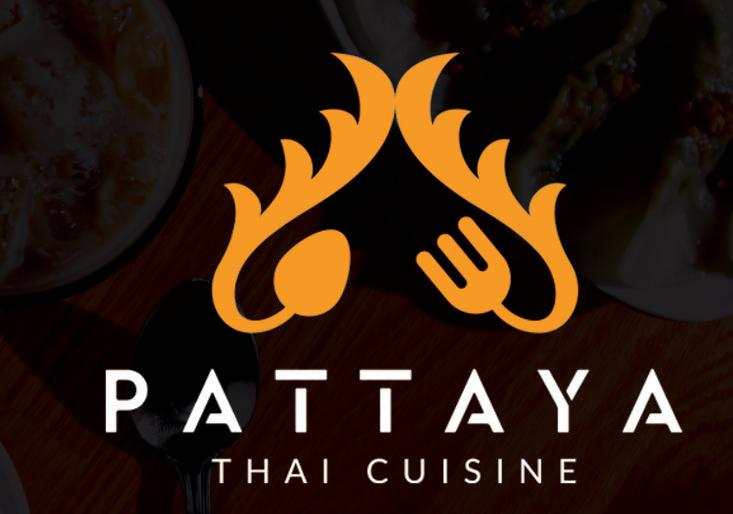

Catering 0 Delivery 0 Takeout 4040 Locust St. pattayarestaurant.com
The Untold Story of the Philadelphia BYO
Your Friday night Ambrosia is a modern day adaptation of a Philadelphia's history of prohibition.
BY MADELINE KOHN
Photo by Natalia Castillo
100years after Prohibition, Philly’s BYO restaurants are modern-day speakeasies.
Rowdy dinners at “bring your own” establishments like Ken’s and Ochatto, cornerstones of Penn’s culture, originally emerged as loopholes to Pennsylvania’s notoriously strict liquor control laws. These laws were imposed in 1933, just days before the repeal of Prohibition, and established a state monopoly over the sale of alcoholic beverages. Consequently, the one Pennsylvania liquor store, Fine Wine and Good Spirits, is state owned. These laws also explain the scarcity of restaurant liquor licenses. Only one license is available for every 3,000 residents of a county, and these certifications are bought and sold between restaurants or auctioned off by the state for upwards of $400,000. Even before large supermarket chains started
snatching up and driving up the price of the very few available liquor licenses, most Pa. restaurants couldn’t legally sell alcohol.
Enter the BYO. From the mountains of red tape surrounding Pennsylvania’s liquor control laws, degeneracy ensues.
In either a fatal oversight, or a stroke of genius, the state of Pennsylvania deemed it acceptable for patrons to bring their own alcohol into restaurants without liquor licenses. Many BYO establishments will provide corkscrews, glassware, and an occasional shameful look to groups of any size bringing outside beverages (purchased legally or not) to their establishment.
Even if the proceeds from those drinks aren’t going to the restaurant itself, customers tend to spend more money on food when they are too drunk to remember what it tastes like. With
the money pre–spent, everyone stuck to their seats, and the bottles already on the table, drinks at a BYO feel free. It would be against the rules, and not to mention a waste, to leave sober.
The prominence of BYOs at Penn reflects the influence of United States alcohol regulation on youth culture. A century ago, Prohibition-era speakeasies were ground zero for mainstream jazz music, Italian–American cuisine, and shorter dresses for women. They were also the first night clubs in the US that allowed men and women to mingle over alcohol, in stark contrast to pre–Prohibition men–only salons. When the state constructs a hurdle to the consumption of alcohol, the people will surmount it. Having to think outside the box from the get–go seems to invite a level of creativity that leaves a broader cultural imprint. In hindsight, the past century of liquor regulation in the U.S. has made liquor consumption more innovative rather than scarce.
Penn’s social organizations have taken advantage of this. Tempered by the formalities of a sit–down dinner, BYOs have been revealed to be a far more comfortable place to drink with a group than a club or a bar. After all, they are much more cost-effective, don’t ask you to be very aware of your surroundings or keep track of your coat, and

Anything related to business goes in one ear and out the other.
34 TH STREET MAGAZINE 36 CAMPUS // STYLE

guarantee that you will be sitting in the same spot for at least an hour and a half. In the way that the secrecy of a speakeasy provided the level of privacy that allowed for more promiscuous social encounters, BYOs are a uniquely convenient setting to get absolutely hammered with your friends.
The nature of regulating one of man’s first vices, alcohol, is somewhat ironic. On the one hand, Pa. laws make it clear that alcohol is something potentially dangerous that should not be widely available. On the other hand, these
rules capitalize on the fact that our culture can’t help but gather around alcohol, to the extent that the state wants to be the only one to promote, and profit off of its sale. These mixed messages have the effect of gathering the youth around the few places they can drink like moths around a lightbulb.
If you make the kids go underground to drink, they will, and, while they're at it, will experiment with music and fashion. If you don’t let them buy drinks at a restaurant, they’ll bring twice as much with them than they
would have bought in the first place. At one point, these adaptations were a happenstance, yet the traditions and cultural icons that form around them, and as a result of them, begin to feel as old as time. This gestures towards the administrative failures of the state government, but even more about the determination of young people to carve out a drinking culture despite, and perhaps due to, attempts to reign it in. Those limitations, and the strides we make to overcome them, turn out to be a blessing in disguise. k
37 MARCH 2024

Breaking Bread at Clark Park
It’s 11:14 a.m. on a muggy Saturday, and Clark Park Farmers' Market is humming with life.
BY KEIRA FENG
Photos by Andrea Barajas
Apple cider donuts, gravelly cello music, a vegetable stand run entirely by three blond tweens, and wailing children scraping their knees in
the middle of the street. Who runs Clark Park?
The Clark Park Farmers’ Market is a collage of West Philadelphia culture. Running
since 1998, the market opens every Saturday morning and features an assortment of produce and trinkets that grant the average Penn student a reprieve from the
PRINT // LEGACY 34 TH STREET MAGAZINE 38
IT // T R
selections of Acme Markets and Gourmet Grocer. But despite the sweetness of its fat blueberries and the delectable crunch of freshly baked bread, the market itself cannot operate without the hands of its vendors.
These are the stories of the people behind the stands—the humans responsible for the mélange of traditions cushioned on 43rd and Baltimore Avenue.
At 11 a.m. on a Saturday, I enter Clark Park in search of one vendor’s familiar jolly grin and his candle–selling stand. After an artless text exchange of “where are you,” and “over here,” I spot Rasheed Daniels waving to me next to a display of ointments and wellness products.
Daniels seems to have traversed all paths of life. After receiving a degree in radio and television production in Atlanta, he found himself at a crossroads, yearning to engage in an industry that allowed him to make a direct impact on people's lives. Dissatisfied with the avenues available in production, he returned to West Philadelphia and transitioned into a behavioral health career.
“I liked it, but I still wasn't doing what I wanted to do. I wanted to apply whatever I had to offer directly, not just doing what someone else recommended,” he says. Reassessing once again, Daniels pursued a master's degree in counseling, which enabled him to work directly with children on the autism spectrum and youth grappling with behavioral problems. Finally, a clearly defined landing point—right?
Not exactly. The paperwork required to be a counselor proved to be demanding and took a toll on him. Then, thanks to his clients, Daniels struck inspiration. As a therapist, many of the people he worked with remarked that he was in a consistently cheerful mood. “How are you always happy? What do you do?” they’d ask, to which he would explain that the majority of his happiness stems from how he approaches health and wellness. For Daniels, this means nourishing your mental health in conjunction with your
physical fitness.
Daniels explains that the majority of the clients he serviced did not have a background in health and wellness and instead came to his workplace for medication. During this time, he noticed that a lot of people experimented with mental health medication but would still report feeling unwell, leading to a cycle of prescribing and re–prescribing. This pattern motivated Daniels to open his business, Native Sun Companies, whose goal is to make healthy products feel and taste good.
“The most rewarding part of all this is getting the opportunity to witness the joy from customers in real–time,” Daniels says. Whether it be an ointment that relieves knee pain or a candle that becomes a cherished birthday gift, Daniels believes that community feedback is the primary reason for the business’s longevity and why he continues returning to the market.
Over time, he’s noticed that the same faces show up at his stand every weekend. “They don't care if it's a snowstorm, they don't care if it's a sunny day. They come by the market. They're dedicated,” he says, smiling.
On this muggy, overcast day, Pound Cake Heaven’s tent is a splash of joyous purple with a myriad of sweets. While founder Pamela Thornton takes a phone call, her husband, bundled up against the cold in a beanie and thick gloves, immediately grins and beckons us closer to the folding table.
“Valentine’s Day is here. You have to have cake on Valentine’s Day,” he insists. He extensively describes each of the remaining pastries: cookies with chocolate centers, miniature strawberry bundts, and assorted pound cakes by the slice. “Cake is the key to a girl’s heart,” he smiles. “I’d know.”
Thornton says that the staple of Pound Cake Heaven is its sour buttercream cake, which she deems as the “classic birthday cake flavor.” Made from two thick slices of cake held together by a thin line of cream, one slice is the size of a small Kleenex box and feels like roughly two pounds in my
hands. It’s immediately clear why it has become the anchor of her menu. The cake’s density is balanced by the sweet brightness of its icing, and it tastes like a treat that could bring you back to life after a particularly tiring day.
The most rewarding part of all this is getting the opportunity to witness the joy from customers in real–time.
“You see, we'd like to take you back to when your mothers and grandmothers used to bake, and you [would] walk in the house and smell that sweet, sweet aroma,” Thornton says. She proudly recounts that recently, a customer walked into Pound Cake Heaven and told Thornton that the smell of the store reminded him of his mother’s baking in his childhood home. “I couldn’t believe it.”
Thornton’s continued devotion to “bringing people home” is one of the reasons why she longs to bring Pound Cake Heaven back to her home in Southwest Philadelphia. Continuing to rebuild post–COVID–19–pandemic, her family is currently fundraising and accumulating support from community organizations to help her company expand back to where she spent her childhood. “If we could pull off this fundraiser, it would be fantastic because I could stand there in that neighborhood and be proud,” she says.
Thornton gives us two gargantuan cupcakes as tokens of her appreciation. I am still armed with a massive tote bag
39 MARCH 2024
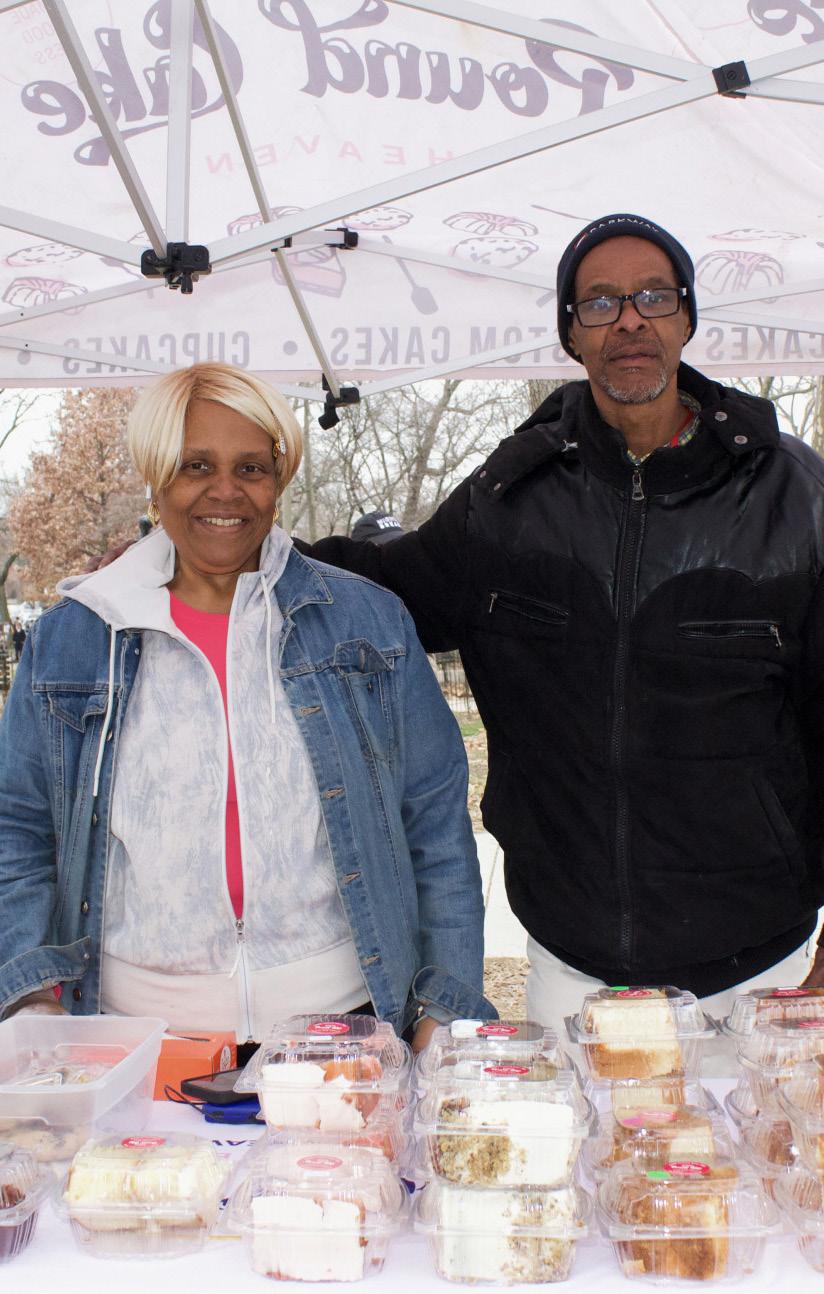
of sweets when I am approached by a tall man holding two glossy magazines. “Are you a Communist?” he asks.
In my previous expeditions to Clark Park, I had often noticed members of the Communist Party holding up kindred magazines and calling out similar phrases: “Do you care about organizing?” “The revolution is now!” Most days, I continue down the street in search of vintage clothes. Today, I stay on the corner of the sidewalk and engage.
He tells me that his name is Chad and that he moved from Lancaster to Philadelphia in September. His group has been regularly advertising the Socialist Revolution at Clark Park for quite some time, but he has only been flyering at this location for three weeks. He says that Clark Park is a remarkably beautiful farmers’ market and that so far, he has had positive conversations with its frequenters.
Chad became involved in the Socialist Revolution because he wants to build a better world. Citing the housing crisis and inadequate healthcare system, he explains that the government has failed its people on numerous accounts. He believes that there is no solving American problems based on a capitalist system and that there is no better time to organize than the present.
“Plus, working sucks,” he tells me.
I thank Chad for his time and continue maneuvering through the crowd of couples in paper boy hats and corduroy overalls. A man begins playing Bach on his lime green cello, and two toddlers pick fights in their wagons. I follow their scuffle until the scent of baked goods leads me to Lost Bread Company, where Peter Griffin is unloading more goods to display underneath his tent.
Griffin is from Bethlehem, Pa., and is currently an adjunct professor of architecture at Temple University. After a year of working with Temple, his sister referred him as a part–time salesperson for Lost Bread Company. “Since then, I have had the luxury of being exposed to
34 TH STREET MAGAZINE 40 CITY // FEATURE
Pamela Thornton (left), the founder of Pound Cake Heaven.
too many baked goods—to my waistline’s groans,” he laughs.
Griffin shares that he was immediately enamored with the community at Clark Park, which is uniquely eclectic and operates on a large scale. Unlike places like Rittenhouse Square, which is dominated by the formal features of its architecture, Clark Park is a people–led space. The constant energy from fascinating customers and friendly vendors make his Saturdays feel less work–like. “I also think it’s a very honorable thing to be able to go and give people nice food or a nice product that you believe in,” he says.
“Why do you believe in Lost Bread?” I ask him.
For one, Griffin says that Lost Bread Company focuses on the locale by sourcing their grains from nearby farms and milling them in Philadelphia. They also aren’t afraid of naturally imperfect products. As opposed to brands sold in mainstream supermarkets, which require invariability from shelf–stable products, Lost Bread Company does not believe in tossing less–than–uniform bread aside; if the bakery’s humidity is off and produces a funky–looking loaf, they happily sell it.
Griffin thinks that because goods sold at farmers' markets depend on seasonality, they resemble a lifestyle closer to that of our ancestors. There is a certain magic in observing farmers selling lush, beautiful greens in the summer before transitioning to tubers and carrots in the winter. “It’s a really lovely thing to be able to think, ‘This is all I can get my hands on, so what can I make with this?’” he says. This responsibility and exploration induce growth and resourcefulness for the market’s customers.
The beauty of being a vendor in the market also lies in the ability to trade, Griffin explains. At the end of the day, he often exchanges his bread with fresh produce from a vegetable vendor or grounds from a coffee stand. Griffin describes it as both a privilege and a low–stakes arrangement; vendors do not go dollar–for–dollar, but rather trade on a barter system—one that allows them to return home with a tre-
mendous bounty of goods.
This highly interactive system, however, is contingent on being able to socialize with one another. Because Griffin has worked with Lost Bread Company since 2018, he’s noticed several changes in the park both pre– and post–pandemic.
Surprisingly, Griffin shares that the pandemic was beneficial to the culture of the farmers’ market. For Lost Bread Company, reconfiguring operations was very arduous, specifically when it came to setting up and tearing down plexiglass shields at every pop–up shop; Griffin likened the experience to moving in and out of a studio apartment every day. However, the pandemic fostered a sense of camaraderie between the vendors at the park. “We recognize each other as people who have been through the same things, even if it’s never been articulated out loud,” he says.

It's all cabbage.
Griffin also believes that the pandemic allowed peripheral vendors to join the Clark Park Farmers’ Market community. These peripheral vendors often sell old records, vintage clothing, and artwork right outside the formal boundaries of 43rd and Baltimore Avenue. Griffin says that prior to COVID–19 restrictions, the Park Association had strictly prohibited external vendors from establishing shops

in the area. However, at the height of the pandemic, people in need of a source of income began selling again on the outskirts of the market. Rather than shutting them down, the Park Association allowed this practice to continue.
“I think it's lovely,” Griffin says. “Who doesn't love a good flea market?”
One of these peripheral vendors is Syd Page, who has been selling intricate collage art at Clark Park since last year. Leaning back in black fingerless gloves and a thick nose ring, Page watches park–goers flip through his viewbook of full–size 8.5–by–11–inch artwork. His collages are a series of unexpected textures and carefully constructed thoughts pulled from different magazine quotations. One collage draws from at least
41 MARCH 2024
Peter Griffin, an adjunct professor of architecture at Temple University and a parttime employee at Lost Bread Company.
seven different tactile sources and reads, “Every / silent cry / full of life / and love.” Beneath a protective layer of plastic is a black–and–white cut–out of a family playing frisbee on the beach, but the original photo’s monochrome ocean has been replaced with a sea of red.
Page tells me that he has been making collages since 2018 and that each collage is individually sacred as a process and a product. He currently owns three unorganized boxes filled with vintage magazines and advertisements and is still accumulating new thrifted materials. For Page, it is equal parts a treasure to search for the elements as it is to create something new.
As more people pass by to look through his flipbook, I notice that each onlooker sees something different in his collages. Page’s collages are deeply personal, works akin to diaries or what he coins “creative confessions.” The work in his viewbook is ordered by date so that he can reflect on where his head was at the time of each collage’s creation.
I tell him that I admire his courage; it seems intimidating to have one’s emotions laid bare for strangers’ observations.
Page, however, thinks that sharing is a gift. “I believe that art should be accessible to as many people as possible, and I like making art that connects with people.”
In the hustle of the Clark Park Farmers’ Market, connection is abundant. Of course, people are zeroed in on themselves, focused on browsing retail and hunting down produce for the week. But despite these surface–level divisions, they are also experiencing the world together: healing their bodies with herbs and oils, tasting whispers of home with a bite of poundcake, and breaking bread with new and familiar faces.
“Coming to Clark Park every week means speaking to people,” Page says as he presents his collection of handmade bookmarks to us. “We are sharing the truths of life.” k

34 TH STREET MAGAZINE 42 CITY // FEATURE
Rasheed Daniels, founder and CEO of Native Sun Companies.
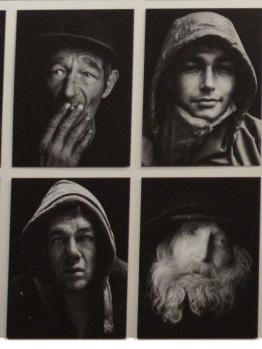
As students across Penn’s campus frantically scramble to fill out next year’s housing application, many find themselves shuddering at the thought of spending a year in the high rises while their friends enjoy lattes at the Gutmann coffee bar. These hardships, though, pale in comparison to the bleak reality of other city residents who find themselves unemployed, uninsured, and unhoused.
The Mütter Museum’s new art exhibit, “Unhoused: Personal Stories and Public Health,” illuminates the complex biosocial underpinnings that drive the unhoused population and its persistence across Philly’s most densely populated regions.
According to the United States Department of Housing and Urban Development, 4,725 individuals experienced homeless-
Amplifying Unhoused Voices Through the Power of Art
The
Mütter Museum’s new art exhibit
explores the unhoused experience through the lens of public health.
BY CHLOE NORMAN
Photos by Preston Chan
ness in 2023, a 5.25 percent increase from 2022. Although post–pandemic rates of homelessness in Philadelphia decreased, 2023 marked the greatest overall annual increase of homelessness that the city has seen within the last 15 years. “Unhoused: Personal Stories and Public Health” reflects the pervasiveness of the unhoused experience across the world while exploring its categorization as a global health crisis.
Created through collaboration between Public Health Chair of the College of Physicians of Philadelphia Rene Najera and Thomas Jefferson University College Fellow Rosie Frasso, the exhibit features artwork from photographer Leah den Bok and artist Willie Baronet. One half of the piece is composed of 40 black and white photographs of unhoused men, women, and children from
across the globe, while the other consists of more than 80 cardboard signs that Baronet bought from unhoused individuals over the course of the last thirty years.
The exhibit reflects Mütter Director Kate Quinn’s desire to shift the museum’s primary focus to health rather than death. With this exhibit, the museum aims to refocus the narrative surrounding being unhoused onto societal factors that have led to this global health crisis, rather than perpetuate a narrative rooted in individualized blame.
Beyond its educational component, the new exhibit reflects art’s potential to enact social change and galvanize broader societal discourse. Through its photographic representation of the emotional tumult that accompanies being unhoused, the ex-

43 MARCH 2024

hibit encourages individuals to consider the unique stories underlying those who found themselves unhoused.
“In most exhibitions, I usually only use five to ten photos, but for this exhibit I was able to use 40,” den Bok said in an interview with Street. “I thought it was wonderful because I wanted to show more photographs and stories to accomplish my two goals for my project—humanizing people’s experience with homelessness and trying to share their stories.”
Inspired by her own mother’s experience with homelessness, den Bok hopes that the exhibit captures the untold stories of the unhoused while challenging preconceived notions of homelessness. By amplifying the voices of the unhoused, she believes that there is infinite potential to cultivate empathy and establish a foundation for meaningful change.
“My mother Sara was homeless as a child,” den Bok said. She further recounted her mother's story, “She was living in Cal-
cutta, India, and a police officer took pity on her because she had a deep wound on her face, and he knew that Mother Teresa dedicated her life to helping those experiencing homelessness. So, he brought her to Mother Teresa’s shelter where she was raised by Mother Teresa and the nuns until the age of five when she was adopted by a family in a small town in Ontario, Canada. Needless to say, if it wasn’t for Mother Teresa dedicating her life to those experiencing homelessness, I wouldn’t be alive today and my mother wouldn’t be alive today.”
Additionally, by placing the unhoused experience into the context of public health, the Mütter Museum hopes to shed light on a neglected facet of the issue and its persistence in contemporary society. Frasso aims to shift the negative connotations associated with homelessness through the amalgamation of art and science.
“The public health lens forces us to look at systemic structures that lead to housing insecurity—and it pushes us to respectfully
consider each individual experience while considering the collective experiences that have led to growing issues, like housing insecurity,” Frasso said in an interview with Street. “We ask, why are people left to live on our streets? What upstream measures could we take to prevent this and, at the same time, what can and do we need to do now to solve the issue? Are there harm reduction strategies that would lessen the risk of poor outcomes for those who are unhoused?”
The exhibit depicts the dehumanization that unhoused people are often forced to endure. In particular, it sheds light on the complexities of the unhoused crisis, a subject about which many housed people remain ignorant.
“We hope, Willie Baronet, Leah den Bok, and I, that our collaboration leads people to consider how they may be contributing to the dehumanization of people living on the street, in shelters, or without a consistent safe, warm place to rest,” Frasso said.
34 TH STREET MAGAZINE 44
CULTURE // FOCUS

“We hope the exhibit gives people space and time to reflect on the crisis at hand. It is far too easy to live your life and not 'see' those that we pass by. Also, the exhibit gives people space to share their own experiences of housing insecurity and what home really means to them.”
Aiming to foster a community of understanding and empathy, the exhibit’s focus on public health allows the public to gain a better grasp on the social factors contributing to the number of unhoused individuals in Philadelphia and to unlearn pernicious stereotypes that continue to unfairly disparage those who find themselves unhoused.
“We wanted to humanize people who are unhoused [in hopes that their stories would resonate with those who came to visit the exhibit] and become proactive in wanting to address housing insecurity,” Najera said in an interview with Street. “We hope that when people now encounter somebody who is unhoused, they may
see them as one of their neighbors and one of their community members instead of somebody to stay away from or somebody to avoid.”
The Mütter Museum will continue its commitment to mitigating the prevalence of homelessness in Philadelphia by partnering with local non profit organizations such as Project HOME. Based in the heart of Philly, the service initiative has worked for 35 years to combat homelessness in the city by providing supportive, affordable, and permanent housing for unhoused individuals and families.
Writing about the impact Project HOME has had on her experience with homelessness, Project HOME resident Bonita wrote in a statement published to the organization’s website that “Project HOME not only provided me with a place to live, but gave me the stability to achieve my goals and care for others. To put others before ourselves is such a beautiful thing. I am so grateful for the commitment of everyone
who helped make my dreams come true. There really is no place like this home.”
Through the Mütter Museum’s new exhibit, students have the opportunity to realize that behind every statistic surrounding homelessness lies a personal narrative, a life plagued by adversity, and a story untold. The museum proves that it is important to humanize the unhoused crisis and recognize the lived realities of those who are unhoused, and to regard them with compassion rather than apathy.
Humanizing the unhoused experience means that society must begin to acknowledge the inherent worth of every individual, regardless of their socioeconomic status, and recognize that being unhoused is not the product of personal deficiency, but instead a direct result of institutional biases, systemic injustices, and mental health toils. By humanizing the unhoused experience, perhaps this exhibit can help to cultivate a society filled with compassion rather than contempt.k
MARCH 2024 45
Take It to the Streets What to Do in Philly This Month
This month: Hugging Exhibition. Award–Winning Plays. Speakeasies. Pictures of Ghosts—and lots more to explore.
Going to college in Philly, we’re so often bombarded—on social media and IRL—with seemingly endless options for how to spend our free time. So I’m delighted to announce that Street has done the hard part for you: We’ve rounded up what we think are the can’t–miss events for the month. If I’ve done my job right, there’ll be something in here for every one of our readers, no matter what you like to do with your weekends.
Catherine Sorrentino, Print Editor
March 14: Dance Masterpieces @ Philadelphia Ballet
No one needs to be a hardcore ballet fan to appreciate the eternally beautiful and exhilarating work of Alvin Ailey, Twyla Tharp, and William Forsythe. This celebration of some of their most famous works represents a true compilation of genius. It’s not to be missed. Ticket Prices Vary, Through March 16, 323 North Broad St
March 20: KWH Speakeasy Open Mic Night @ Kelly Writers House
Come down to the Kelly Writers House for an open mic night that welcomes all kinds of readings, performances, spectacles, and happenings! Whether you’ve just finished an award–winning essay or you’re part of a modern dance troupe, Kelly Writers House welcomes all. Free, 7:00 p.m., 3805 Locust Walk
March 22–March 23: Rennie Harris
March 12: Art of the Brick Exhibit
@ The Franklin Institute
Tap into your inner ten–year–old at the new visiting exhibit Art of the Brick at The Franklin Institute. We’re talking life size Lego animals, Lego dresses, and the iconic sculpture of a guy ripping open his chest to reveal … you guessed it, Legos.
$20, Through Sept. 2, 222 N 20th St
March 12: Risa Puno: Group Hug
@ The Fabric Workshop
“Kapwa” is a pre–colonial Philippine concept that represents “a deeply shared identity and the belief that we have a moral imperative to care for others as we do ourselves.” As a central notion to Risa Puno’s first solo exhibition Group Hug, kapwa captures both the interactive features of the exhibition and the artist’s intent to explore the complex social relations in receiving and giving care.
Free, Through July 21, 1214 Arch St
March 12: Public Art in Philadelphia Exhibit @ The Historical Society of Pennsylvania
Highlighting the historic accomplishments and recent contributions of women artists, benefactors and leaders, the Association for
Public Art presents Public Art in Philadelphia Exhibition: A Legacy Shaped by Women. Tracing the captivating history of early 20th century female artists, the exhibition cogently adds to a larger conversation surrounding the intersection of art and representation.
Free, Through March 15, 1300 Locust St
March 12: Alexey Brodovich
– Astonish Me @ The Barnes Foundation
Alexey Brodovich, designer and photographer at Harper’s Bazaar, has his work on exhibition at the Barnes Foundation starting this month. Don’t miss the work of one of the most influential photographers of the 20th century. $5 with student ID, 2025 Benjamin Franklin Pkwy
March 12–Apr. 7: The Lehman Trilogy @ The Arden
Witness the Philadelphia premiere of the Tony Award–winning play The Lehman Trilogy Staged in one of Philadelphia’s local theaters, this play centers around the 2008 financial crisis and spans three generations of a family history. You’ll want to call your mom after, but in a good way.
$30-$60, 40 N 2nd St
Puremovement American Street Dance Theatre @ Annenberg Center
Forget Shake It Up. See this 30–year retrospective curated by hip–hop choreographer Rennie Harris right on Penn’s campus.
$10 with Penn ID, 3680 Walnut St
March 23: Sound Type with Victoria Shen @ Black Box Theatre
DIY music for all electropop experimental listeners, show out at the inaugural concert of the SOUND TYPE Music Festival by Asian Arts Initiative. Victoria Shen, self–described sound artist/experimentalist, is opened by Levi Lu. $20, 8:00 p.m., 1219 Vine St
March 23: Pictures of Ghosts @ Lightbox Film Center
Acclaimed Brazilian director Kleber Mendonça’s newest film Pictures of Ghosts is coming to Philadelphia for a one–night–only special limited engagement! With archival material and photographs and moving images found in personal collections, Pictures of Ghosts explores the urban landscape of Recife, while gradually developing into a map of a city through the lens of cinema.
$8 with Student ID, 7:00 p.m., 401 South Broad St
PRINT // LEGACY 34 TH STREET MAGAZINE 46 EVENTS CALENDAR







Subscribe to see what’s toastin’ every Monday - Wednesday - Friday
Foodies
Deliveries + Shopping Sprees
O ering 60+ eateries, stores, and entertainment venues, Shop Penn has what you need to stay warm this season.

Winter calls for comfort food and cozy clothes, so get your cold weather cures at Shop Penn.

Wants Needs +
Must-Haves

Shop Local.
Shop Penn.
#SHOPPENN
@SHOPSATPENN

SHOPSATPENN.COM






























































































































 LEGACY CULTURE STYLE
LEGACY CULTURE STYLE


 LEGACY
LEGACY





































